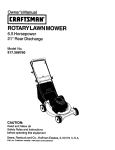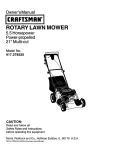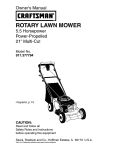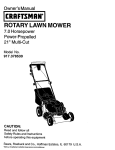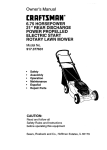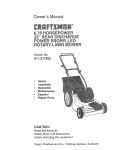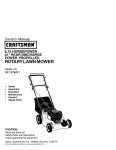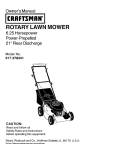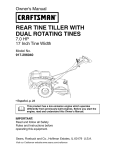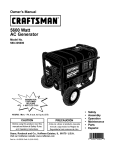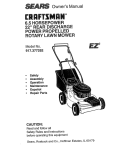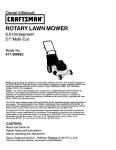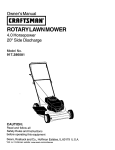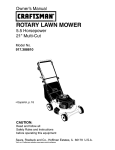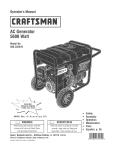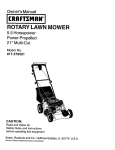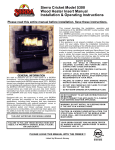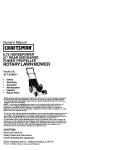Download Craftsman 917.388801 Owner`s manual
Transcript
Owner's Manual
JCRI_FT$1VlAH*
J
ROTARY LAWN MOWER
5.5 Horsepower
21" Multi-Cut
Model No.
917.388801
CAUTION:
Read and follow all
Safety Rules and Instructions
before operating this equipment
Sears, Roebuck and Co., Hoffman Estates, IL 60179 U.S.A.
Visit our Craftsman website: www.sears.com/craftsman
Warranty .................................................
2
Safety Rules ........................................
2-4
Assembly / Pre-Operation
......................
5
Operation ...........................................
6-10
Maintenance
Schedule ........................
1!
Maintenance
....................................
11-14
LIMITED
TWO YEAR WARRANTY
Product Specifications
..........................
12
Service and Adjustments ................. 14-15
Storage ............................................
15-16
Troubleshooting
..............................
16-17
Repair Parts .....................................
34-39
Sears Service .........................
Back Cover
ON CRAFTSMAN
POWER MOWER
For two years from date of purchase, when this Craftsman Lawn Mower is maintained,
lubricated, and tuned up according to the operating and maintenance
instructions
in
the owner's manual, Sears will repair free of charge any defect in material or workmanship.
If this Craftsman Lawn Mower is used for commercial
applies for only 90 days from the date of purchase.
or rental purposes,
this warranty
This Warranty does not cover:
• Expendable
items which become worn during normal use, such as rotary mower
blades, blade adapters, belts, air cleaners and spark plug.
• Repairs necessary
because of operator abuse or negligence,
including bent
crankshafts
and the failure to maintain the equipment according to the instructions
contained
in the owner's manual.
Warranty service is available by returning the Craftsman power mower to the nearest
Sears Service Center/Department
in the United States. This warranty applies only
while this product is used in the United States.
This Warranty gives you specific
vary from state to state.
SEARS,
ROEBUCKAND
legal rights, and you may also have other rights which
CO., D/817 WA, HOFFMAN
IMPORTANT:
This cutting machine
throwing objects. Failure to observe
serious injury or death.
ESTATES,
ILLINOIS
60179
is capable of amputating hands and feet and
the following safety instructions could result in
_,Look for this symbol to point out
important safety precautions.
It means
CAUTION!!!
BECOMEALERT!!!
YOUR
SAFETY IS INVOLVED.
a_,WARNING: Battery posts, terminals and
related accessories
contain lead and
lead compounds,
chemicals known to the
State of California to cause cancer and
birth defects or other reproductive
harm.
Wash hands after handling.
_, WARNING:
In order to prevent
accidental starting when setting up,
transporting,
adjusting or making repairs,
always disconnect
spark plug wire and
place wire where it cannot contact spark
plug.
A_ CAUTION:
Muffler and other engine
parts become extremely hot during
operation and remain hot after engine
has stopped. To avoid severe burns on
contact, stay away from these areas.
_I,WARNING:
Engine exhaust, some of
its constituents,
and certain vehicle
components
contain or emit chemicals
known to the State of California to cause
cancer and birth defects or other reproductive harm.
_3_
2
,.
I. GENERAL
OPERATION
• If the equipment should start to vibrate
abnormally, stop the engine (motor)
and check immediately
for the cause.
Vibration is generally a warning of
trouble.
• Always wear safety goggles or safety
glasses with side shields when operating mower.
• Read, understand, and follow all
instructions on the machine and in the
manual(s) before starting. Be thoroughly familiar with the controls and
the proper use of the machine before
starting.
• Do not put hands or feet near or under
rotating parts. Keep clear of the
discharge opening at all times.
• Only allow responsible individuals,
who are familiar with the instructions, to
operate the machine.
• Clear the area of objects such as
rocks, toys, wire, bones, sticks, etc.,
which could be picked up and thrown
by the blade.
• Be sure the area is clear of other
•
•
•
•
•
•
•
•
•
•
•
II. SLOPE
OPERATION
Slopes are a major factor related to slip
and fall accidents which can result in
severe injury. All slopes require extra
caution. If you feel uneasy on a slope, do
not mow it.
DO:
• Mow across the face of slopes: never
up and down. Exercise extreme caution
when changing direction on slopes.
• Remove obstacles such as rocks, tree
limbs, etc.
• Watch for holes, ruts, or bumps. Tall
grass can hide obstacles.
DO NOT:
people before mowing. Stop machine if
anyone enters the area.
Do not operate the mower when
barefoot or wearing open sandals.
Always wear substantial foot wear.
Do not pull mower backwards unless
absolutely necessary. Always look
down and behind before and while
moving backwards.
Do not operate the mower without
proper guards, plates, grass catcher or
other safety protective devices in place.
See manufacturer's
instructions for
• Do not trim near drop-offs, ditches or
embankments.
The operator could lose
footing or balance.
• Do not trim excessively steep slopes.
• Do not mow on wet grass. Reduced
footing could cause slipping.
proper operation and installation of
accessories.
Only use accessories
approved by the manufacturer.
Stop the blade(s) when crossing gravel
drives, walks, or roads.
Stop the engine (motor) whenever you
leave the equipment, before cleaning
the mower or unclogging the chute.
Shut the engine (motor) off and wait
until the blade comes to complete stop
before removing grass catcher.
Mow only in daylight or good artificial
light.
Do not operate the machine while
under the influence of alcohol or drugs.
Never operate machine in wet grass.
Always be sure of your footing: keep a
firm hold on the handle and walk; never
run.
Disengage the self-propelled
mechanism or drive clutch on mowers so
equipped before starting the engine
(motor).
IlL CHILDREN
Tragic accidents can occur if the operator
is not alert to the presence of children.
Children are often attracted to the
machine and the mowing activity. Never
assume that children will remain where
you last saw them.
• Keep children out of the trimming area
and under the watchful care of another
responsible
adult.
• Be alert and turn machine off if children
enter the area.
• Before and while walking backwards,
look behind and down for small
children.
• Never allow children to operate the
machine.
• Use extra care when approaching
blind
corners, shrubs, trees, or other objects
that may obscure vision.
3
IV. SERVICE
• Never tamper with safety devices.
Check their proper operation regularly.
• Keep machine free of grass, leaves, or
other debris build-up. Clean oil or fuel
spillage. Allow machine to cool before
storing.
• Stop and inspect the equipment
if you
strike an object. Repair, if necessary,
before restarting.
• Never attempt to make wheel height
adjustments
while the engine (motor) is
running.
• Grass catcher components
are subject
to wear, damage, and deterioration,
which could expose moving parts or
allow objects to be thrown. Frequently
check components
and replace with
manufacturer's
recommended
parts,
when necessary.
• Mower blades are sharp and can cut.
Wrap the blade(s) or wear gloves, and
use extra caution when servicing them.
• Do not change the engine governor
setting or overspeed the engine.
• Use extra care in handling gasoline
and other fuels. They are flammable
and vapors are explosive.
-Use only an approved container.
- Never remove gas cap or add fuel
with the engine running. Allow
engine to cool before refueling. Do
not smoke.
-Never refuel the machine indoors.
- Never store the machine or fuel
container inside where there is an
open flame, such as a water heater.
• Never run a machine inside a closed
area.
• Never make adjustments
or repairs
with the engine (motor) running.
Disconnect the spark plug wire, and
keep the wire away from the plug to
prevent accidental
starting.
• Keep nuts and bolts, especially blade
attachment bolts, tight and keep
equipment
in good condition.
These accessories were available when this lawn mower was produced. They are not
shipped with your mower. They are also available at most Sears retail outlets and service
centers. Most SeArs stores can also order repair parts for you, when you provide the model
number of your lawn mower. Some of these accessories may not apply to your lawn mower.
LAWN MOWER PERFORMANCE
J
CLIPPING DEFLECTOR
FOR REAR DISCHARGE LAWN MOWERS
MULCHER
GRASS CATCHERS
FOR
REAR DISCHARGE
LAWN MOWERS
KITS
STABILIZER
FOR
SIDE DISCHARGE
GRASS
LAWN CATCHERS
MOWERS
GAS CANS
LAWN
MOWER
MAINTENANCE
MUFFLERS
BELTS
AIR FILTERS
BLADES
BLADE ADAPTERS
4
SPARK PLUGS
WHEELS
ENGINE OIL
HOW TO SET UP YOUR LAWN
MOWER
Read these instructions and this manual
in its entirety before you attempt to
assemble or operate your new lawn
mower.
IMPORTANT: This lawn mower is shipped
WITHOUT OIL OR GASOLINE
in the
TO UNFOLD
HANDLE
IMPORTANT:
Unfold handle carefully so
as not to pinch or damage control cables.
1. Raise handles until lower handle
engine.
Your new lawn mower has been assembled at the factory with the exception
of those parts left unassembled
for
shipping purposes.
To ensure safe and
proper operation of your lawn mower, all
parts and hardware you assemble must
be tightened securely. Use the correct
tools as necessary to ensure proper
tightness.
All parts such as nuts, washers, bolts, etc., necessary to complete the
assembly have been placed in the parts
bag.
section locks into place in mowing
position.
2. Remove protective padding, raise
upper handle section into place on
lower handle and tighten both handle
knobs.
3. Remove handle padding holding
operator presence control bar to upper
handle.
Your lawn mower handle can be adjusted
for your mowing comfort. Refer to
"ADJUST HANDLE" in the Service and
Adjustments
section of this manual.
TO REMOVE LAWN MOWER FROM
CARTON
Operator
control bar
1. Remove loose parts included with
mower.
2. Cut down two end corners of carton
and lay end panel down flat.
3. Remove all packing materials except
padding between upper and lower
handle and padding holding operator
presence control bar to upper handle.
4. Roll lawn mower out of carton and
check carton thoroughly for additJonal
loose parts.
Upper
LIFT
UF
Mowing
position
Lower handle
TO INSTALL
ATTACHMENTS
Your lawn mower was shipped ready to
be used as a mulcher. To convert to
bagging or discharging,
see 'q-O CONVERT MOWER" in the Operation section
of this manual).
5
KNOWYOUR
LAWN MOWER
READ THIS OWNER'S MANUALAND ALL SAFETY RULES BEFORE OPERATING YOUR
LAWN MOWER. Compare the illustra'dons with your lawn mower to familiarize yourself with
the location of various controls and adjustments. Save this manual for future reference.
These symbols may appear on your lawn mower or in literature
product.
Learn and understand
their meaning.
CAUTION
OR WARNING
ENGINE
ON
ENGINE
OFF
FAST
SLOW
CHOKE
FUEL
supplied
OIL
with the
DANGER, KEEP HANDS
AND FEET AWAY
-Operator presence control bar
Throttle/
choke
knob
Starter
handle
Gasoline filler cap
Fuel valve lever
Grass
catcher
Air tilter
Engine oil cap
with
Housing
Mulcher
Wheel adjuster
(on each wheel)
IMPORTANT:
This lawn mower
MEETS CPSC SAFETY
is shipped
WITHOUT
OIL OR GASOLINE
in the engine.
REQUIREMENTS
Sears rotary walk-behind power lawn mowers conform to the safety standards of the
American National Standards Institute and the U.S. Consumer Product Safety Commission. The blade turns when the engine is running.
Operator presence control bar - must be
held down to the handle to start the engine.
Release to stop the engine.
Mulcher door - allows conversion to
discharging
or bagging operation.
Throttle/choke
control - used for starting
the engine; & allows you to select either
CHOKE or FAST engine speed.
Starter handle - used for starting the engine.
6
TO ADJUST
The operation of any lawn
mower can result in foreign
objects thrown into the
eyes, which can result in
severe eye damage.
Always wear safety glasses or eye
shields while operating your lawn mower
or performing any adjustments
or repairs.
We recommend a standard safety
glasses or wide vision safety mask worn
over spectacles.
HOWTO
ENGINE
CUTTING
HEIGHT
Raise wheels for low cut and lower
wheels for high cut, adjust cutting height
to suit your requirements. Medium
position is best for most lawns.
• To change cutting height, squeeze
adjuster lever toward wheel. Move
wheel up or down to suit your requirements. Be sure all wheels are in the
same setting.
NOTE: Adjuster is properly positioned
when plate tab inserts into hole in lever.
Also, 9-position adjusters (if so equipped)
allow lever to be positioned between the
plate tabs.
USE YOUR LAWN MOWER
CONTROL
The engine is controlled by a throttle
control located on the side of the upper
handle. CHOKE position is for starting a
cold engine and FAST position is for
starting a warm engine and normal
operation.
The engine speed is not
adjustable.
LOWER WHEELS FOR HIGH CUT
RAISE WHEELS FOR LOW CUT
CHOKE
TO CONVERT
Lever
MOWER
Your lawn mower was shipped ready to
be used as a mulcher. To convert to
bagging or discharging:
REAR BAGGING
• Lift rear door of the lawn mower and
place the grass catcher frame hooks
onto the door pivot pins.
• To convert to mulching or discharging
operation, remove grass catcher and
close rear door.
Pivot
ENGINE
"
ZONE CONTROL
_CAUTION:
Federal regulations
require
an engine control to be installed on this
lawn mower in order to minimize the risk
of blade contact injury. Do not under any
circumstances
attempt to defeat the
function of the operator control. The blade
turns when the engine is running.
• Your lawn mower is equipped with an
operator presence control bar which
requires the operator to be positioned
behind the lawn mower handle to start
and operate the lawn mower.
Catcher frame hook
7
Rear
Grass
catcher
handle
/
SIDE DISCHARGING
• Rear door must be closed.
• Open mulcher door and install discharge deflector under door as shown.
• Mower is now ready for discharging
operation.
• To convert to mulching or bagging
operation, discharge deflector must be
removed and mulcher door must be
closed.
SIMPLE STEPS TO REMEMBER
WHEN
CONVERTING
YOUR LAWN MOWER
FOR MULCHING 1. Rear door closed.
2. Mulcher door closed.
FOR REAR BAGGING 1. Grass catcher installed.
2. Mulcher door closed.
FOR SIDE DISCHARGING
-
1. Rear door closed.
2. Side discharge deflector installed.
ACAUTION:
Do not run your lawn
mower without rear door closed, clipping
deflector
or approved grass catcher in
place. Never attempt to operate the lawn
mower with the rear door removed or
propped open.
TO EMPTY
GRASS
CATCHER
1. Lift up on grass catcher
frame handle.
using the
2.
Remove grass catcher with clippings
from under lawn mower handle.
3. Empty clippings from bag using both
frame handle and bag handle.
NOTE: Do not drag the bag when
emptying;
it will cause unnecessary wear.
Grass
catcher
frame
handle
Bag
handle
BEFORE
STARTING
ENGINE
ADD OIL
Discharge
Your lawnmower
is shipped without oil in
the engine. For type and grade of oil to
mulcher door
use, see "ENGINE" in the Maintenance
section of this manual.
A CAUTION:
DO NOT overfill engine with
oil, or it will smoke on startup.
1. Be sure lawnmower is level and area
around oil fill is clean.
2. Remove oil dipstick from oil fill spout.
Make sure that rim of spout is clean.
3. You receive a container of oil with the
unit. Slowly pour 3/4 (12 oz.) of the oil
from the container down the oil fill
spout into the engine.
4. Wait one minute to allow oil to settle.
Use guage on oil fill cap/dipstick for
checking level. Insert dipstick into the
tube and rest the oil fill cap on the
tube. DO NOT thread the cap into the
tube when taking reading.
.
Continue adding small amounts of oil
and rechecking the dipstick until it
reads full. DO NOT overfill, or engine
8
will smoke on startup.
6. Alwaysbe sureto retightenoil dipstick
beforestarting engine.
TO START
ENGINE
NOTE: Due to protective coatings on the
engine, a small amount of smoke may be
present during the initial use of the
product and should be considered
normal.
1. Turn fuel valve to ON position.
2. To start a cold engine, move handle
mounted throttle/choke control lever to
CHOKE position.
3. Hold operator presence control bar
down to the handle and pull starter
handle quickly. Do not allow starter
rope to snap back.
4. Slowly move throttle control lever to
FAST position after engine starts.
• To start a warm engine, move throttle
control lever to FAST position, then
follow steps above.
• Check oil level before each use. Add
oil if needed.
Fill to full line on dipstick.
• Change the oil after every 25 hours of
operation or each season. You may
need to change the oil more often
under dusty, dirty conditions.
ADD GASOLINE
• Fill fuel tank to bottom of tank filler
neck. Do not overfill. Use fresh, clean,
regular unleaded gasoline with a
minimum of 87 octane. Do not mix oil
with gasoline. Purchase fuel in
quantities that can be used within 30
_lbdays to assure fuel freshness.
CAUTION:
Wipe off any spilled oil or
fuel. Do not store, spill or use gasoline
near an open flame.
A CAUTION:
Alcohol blended fuels
(called gasohol or using ethanol or
methanol) can attract moisture which
leads to separation and formation of
acids during storage.
Acidic gas can
damage the fuel system of an engine
while in storage. To avoid engine
problems, the fuel system should be
emptied before storage of 30 days or
longer. Drain the gas tank, start the
engine and let it run until the fuel lines
and carburetor are empty. Use fresh fuel
next season. See Storage Instructions for
additional information.
Never use engine
or carburetor cleaner products in the fuel
tank or permanent damage may occur.
TO STOP ENGINE
• To stop engine, release operator
presence control bar. Wait until blade
and all moving parts have stopped and
turn fuel valve to OFF position if you do
not intend to restart the engine soon.
ON
Fuel valve lever
Upper limit
Lower limit
Gasoline
filler cap
Oil
cap
9
MOWING
MULCHING MOWINGTIPS
TIPS
IMPORTANT: For best performance, keep
mower housing free of built-up grass and
trash. See "CLEANING" in the Maintenance
section of this manual.
• Under certain conditions,
such as very
tall grass, it may be necessary to raise
the height of cut to reduce pushing
effort and to keep from overloading the
engine and leaving clumps of grass
clippings. It may also be necessary to
reduce ground speed and/or run the
lawn mower over the area a second
time.
• For extremely heavy cutting, reduce the
width of cut by overlapping
previously
cut path and mow slowly.
• For better grass bagging and most
cutting conditions,
the engine speed
should be set in the FAST position.
• Pores in cloth grass catchers can
become filled with dirt and dust with
use and catchers will collect less grass.
To prevent this, regularly hose catcher
off with water and let dry before using.
• Keep top of engine around starter clear
and clean of grass clippings and chaff.
This will help engine air flow and
extend engine life.
• The special mulching blade will recut the
gross clippings many times and reduce
them in size so that as they fall onto the
lawn they will disperse into the grass and
not be noticed. Also, the mulched grass
will biodegrade quickly to provide nutrients
for the lawn. Always mulch with your
highest engine (blade) speed as this will
provide the best recutting action of the
blades.
• Avoid cutting your lawn when it is wet. Wet
grass tends to form clumps and interferes
with the mulching action. The best time to
mow your lawn is the early aftemoon. At
this time the grass has dried and the newly
cut area will not be exposed to the direct
sun.
• For best results, adjust the lawn mower
cutting height so that the lawn mower cuts
off only the top one-third of the grass
blades, if the lawn is overgrown it will be
necessary to raise the height of cut to
reduce pushing effort and to keep from
overloading the engine and leaving
clumps of mulched grass. For extremely
heavy grass, reduce your width of cut by
overlapping previously cut path and mow
slowly.
MAXI_
• Certain types of grass and grass conditions may require that an area be mulched
a second time to completely hide the
clippings. When doing a second cut, mow
across or perpendicular to the first cut path.
• Change your cutting pattern from week to
week. Mow north to south one week then
change to east to west the next week. This
will help prevent matting and graining of
the lawn.
10
"
AS YOUCOMPLETE
REGULARSERVICE
/_.,_'_
/__/7£."_
_..._0_/._ "
_3_/_"/_."__'/£_
f
I_/
I
Check for Loose Fasteners
Clean/Inspect Grass Catcher
_
M
(If
Equipped)
Clean
Lawn Mower
t/
O
(Power-Propelled
Clean Under DriveMowers)
Cover
Check drive belt/pulleys
E
(Power-Propelled Mowers)
Check/Sharpen/Replace
I
_
SERVICE
DATES
m
_
_,/
If
Blade
_#f3
Lubrication Chart
tf
I_
If
I/'4
Clean Battery/Recharge
IElectdc
E
N
G
I
Start Mowers !
Check Engine Oil Lever
I,/
I
Chan_le En£ine Oil
Clean Air Filter
I_1'1,2
Ii/ 2
Inspect Muffler
_'
t/
N
Clean or Replace Spark Plug
E Replace Air Filter Paper Cartridge
12 3 4 -
1_2
Change more olten when operating under a heavy toad or in high ambient temperatures.
Sewice more often when operating in dirty or dusty conditions.
Replace blades more often when mowing in sandy soil.
Charge 48 hours at end of season.
GENERAL
RECOMMENDATIONS
LUBRICATION
The warranty on this lawn mower does not
cover items that have been subjected to
operator abuse or negligence. To receive full
value from the warranty, operator must
maintain mower as instructed in this manual.
Some adjustments will need to be made
periedically to properly maintain your unit.
All adjustments in the Service and Adjustments section of this manual should be
checked at least once each season.
• Once a year, replace the spark plug, clean
or replace air filter element and check
blade for wear. A new spark plug and
clean/new air filter element assure proper
air-fuel mixture and help your engine run
better and last longer.
• Follow the maintenance schedule in this
manual.
CHART
Wheel
adjuster (on
each wheel)
(!) Mulcher
door hinge pin
Rear door
hinge
(_) Handle bracket mounting pins
BEFORE EACH USE
(_) Spray lubricant
• Check engine oil level.
• Check for loose fasteners.
(_) See "ENGINE" in Maintenance section.
LUBRICATION
Keep unit well lubricated (See "LUBRICATION
CHAR-F').
11
IMPORTANT:
Do not oil or grease
plastic wheel bearings.
Viscous
lubricants will attract dust and dirt that
will shorten the life of the self-lubricating bearings.
If you feel they must be
lubricated, use only a dry, powdered
graphite type lubricant sparingly.
=RODUCT
Serial
SPECIFICATIONS
Number:
Date of Purchase:
iasoline
Capacity
/ Type:
1.0 Quarts (Unleaded
Oil Type (API-SF-SJ):
SAE 10W30
Oil Capacity:
18.5 Ounces
Spark Plug (Gap:
.030")
Blade Bolt Torque:
Regular)
NGK BPR6ES
35-40 ft. Ibs.
• The model and serial numbers will be found on a decal on the rear of the mower
housing.
Record both serial number and date of purchase in space provided above.
LAWN MOWER
(opposite sharp edge) is up toward
the engine.
4. Install the blade bolt with the lock
washer and hardened washer into
blade adapter and crankshaft.
5. Use block of wood between blade and
lawn mower housing and tighten the
blade bolt, turning clockwise.
• The recommended
tightening torque is
35-40 ft. Ibs.
IMPORTANT:
Blade bolt is grade 8 heat
treated.
TO SHARPEN BLADE
Always observe safety rules when performing any maintenance.
TIRES
• Keep tires free of gasoline, oil, or insect
control chemicals which can harm rubber.
• Avoid stumps, stones, deep ruts, sharp
objects and other hazards that may cause
tire damage.
BLADE
CARE
For best results, mower blade must be
kept sharp. Replace bent or damaged
blades.
TO REMOVE
NOTE: We do not recommend sharpening blade - but if you do, be sure the
blade is balanced.
Care should be taken to keep the blade
balanced. An unbalanced blade will
cause eventual damage to lawn mower
or engine.
• The blade can be sharpened with a file
or on a grinding wheel. Do not attempt
to sharpen while on the mower.
• To check blade balance, drive a nail
into a beam or wall. Leave about one
inch of the straight nail exposed. Place
center hole of blade over the head of
the nail. If blade is balanced, it should
remain in a horizontal position. If either
end of the blade moves downward,
sharpen the heavy end until the blade
is balanced.
BLADE
1. Disconnect spark plug wire from spark
plug and place wire where it cannot
come in contact with spark plug.
2. Turn lawn mower on its side. Make
sure air filter and carburetor are up.
3. Use a wood block between blade and
mower housing to prevent blade from
turning when removing blade bolt.
NOTE: Protect your hands with gloves
and/or wrap blade with heavy cloth.
4. Remove blade bolt by turning counterclockwise.
5.
Remove blade and attaching hardware (bolt, lock washer and hardened
washer).
NOTE: Remove the blade adapter and
check the key inside hub of blade
adapter. The key must be in good condition to work properly. Replace adapter if
damaged.
TO REPLACE
Blade adaptm
BLADE
Crankshaft
Blade
1. Position the blade adapter on the
engine crankshaft.
Be sure key in
adapter and crankshaft
keyway are
aligned.
2. Position blade on the blade adapter
aligning the two (2) holes in the blade
with the raised lugs on the adapter.
3. Be sure the trailing edge of blade
12
Blade
bolt
Hardene
washer
_ __y
Trailing edge
;rank
shaft
Blade adapter
GRASS
CATCHER
Oil filler cap/dipstick
• The grass catcher may be hosed with
water, but must be dry when used.
• Check your grass catcher often for
damage or deterioration.
Through
normal use it will wear. If catcher needs
replacing, replace only with a manufacturer approved replacement
catcher.
Give the lawn mower model number
when ordering.
ENGINE
LUBRICATION
AIR FILTER
Use only high quality detergent oil rated
with API service classification
SF-SJ.
Select the oil's SAE viscosity grade
according to your expected operating
temperature.
Your engine will not run properly and may
be damaged by using a dirty air filter.
Replace the air filter every 100 hours of
operation or every season, whichever
occurs first. Service air cleaner more
often under dusty conditions.
SAE VISCOSITY GRADES
-_
T_MPERATURE
.io
RANGE
o
ANT_IPATED
1'0
BEFORE
TO
1.
2.
3.
CLEAN AIR FILTER
Remove cover.
Carefully remove cartridge.
Clean by gently tapping on a flat
surface. If very dirty, replace cartridge.
_I, CAUTION:
Petroleum solvents, such
as kerosene, are not to be used to clean
cartridge. They may cause deterioration of
the cartridge. Do not oil cartridge. Do not
use pressurized air to clean or dry
cartridge.
4. Install cartridge, then replace cover.
_o
NEXT
OIL
CHANGE
NOTE: Multi-viscosity
oils (5W30, 10W30
etc.) improve starting in cold weather, and
you should check your engine oil level
frequently to avoid possible engine
damage from running low on oil.
Change the oil after every 25 hours of
operation or at least once a year if the
lawn mower is not used for 25 hours in
Filter
one year.
Check the crankcase oil level before
starting the engine and after each five (5)
hours of continuous use. Tighten oil plug
securely each-time you check the oil level.
TO CHANGE
ENGINE
Fitter
Cover
Tabs
OIL
NOTE: Before tipping lawn mower to
drain oil, drain fuel tank by running
engine until fuel tank is empty.
1. Disconnect spark plug wire from spark
plug and place wire where it cannot
come in contact with spark plug.
2. Remove engine oil cap; lay aside on a
clean surface.
3. Tip lawn mower on its side as shown
and drain oil into a suitable container.
Rock lawn mower back and forth to
remove any oil trapped inside of
engine.
4. Wipe off any spilled oil from lawn
mower or side of engine.
5. Fill engine with oil. (See "ADD OIL" in
the Operation section of this manual).
6. Reconnect spark plug wire to spark
plug.
Tabs
MUFFLER
Inspect and replace corroded muffler as it
could create a fire hazard and/or damage.
SPARK
PLUG
Replace spark plug at the beginning of
each mowing season or after every 100
hours of operation, whichever occurs first.
Spark plug type and gap setting are
shown in "PRODUCT SPECIFICATIONS"
in Maintenance
section of this manual.
13
CLEANING
IMPORTANT:
For best performance, kiip
mower housing free of built-grass and
trash. Clean the underside of your mower
after each use.
_I_CAUTION:
Disconnect spark plug wire
from spark plug and place wire where it
cannot come in contact with spark plug.
• Clean the underside of your lawn
mower by scraping to remove build-up
of grass and trash.
A WARNING:
To avoid serious injury,
before performing
any service and
adjustments:
1. Release control bar and stop engine.
2. Make sure the blade and all moving
parts have completely
stopped.
3. Disconnect spark plug wire from spark
plug and place where it cannot come
in contact with plug.
LAWN MOWER
TO ADJUST CUTTING HEIGHT
See 'qO ADJUST CUI-IING
HEIGHT"
the Operation section of this manual.
REAR DEFLECTOR
in
The rear deflector, attached between the
rear wheels of your mower, is provided to
minimize the possibility that objects will
be thrown out of the rear of the mower
into the operator mowing position.
If the
deflector becomes damaged, it should be
replaced.
TO ADJUST HANDLE
The upper handle may
four (4) different height
1. Loosen both handle
enough to allow the
pivot to the desired
position.
2. Tighten both handle
• Clean engine often to keep trash from
accumulating.
A clogged engine runs
hotter and shortens engine life.
• Keep finished surfaces and wheels free
of all gasoline, oil, etc.
• We do not recommend using a garden
hose to clean lawn mower unless the
electrical system, muffler, air filter and
carburetor are covered to keep water
out. Water in engine can result in
shortened engine life.
TO ASSEMBLE
CATCHER
1. Put grass catcher frame into grass bag
with rigid part of bag on the bottom.
Make sure the frame handle is outside
of the bag top.
2. Slip vinyl bindings over frame.
NOTE: If vinyl bindings are too stiff, hold
them in warm water for a few minutes. If
bag gets wet, let it dry before using.
_,CAUTION:
Do not run your lawn
mower without clipping deflector or
approved grass catcher in place. Never
attempt to operate the lawn mower with
the rear door removed or propped open.
Catcher
frame
handle
be adjusted to
positions.
knobs only
upper handle to
adjustment
"_._
knobs securely.
ENGINE
ENGINE
Frame
opening
SPEED
Your engine speed has been factory set.
Do not attempt to increase engine speed
or it may result in personal injury. If you
believe that engine is running too fast or
too slow, take your mower to a Sears or
other qualified service center for repair
and adjustment.
Handle
,:_:_:..
GRASS
knob
Handle
knob
14
CARBURETOR
IMPORTANT"
Never tamper with the
engine governor, which is factory set for
proper engine speed. Overspeeding
the
engine above the factory high speed
setting can be dangerous.
If you think the
engine-governed
high speed needs
adjusting, contact a Sears or other
qualified service center, which has proper
equipment and experience to make any
necessary adjustments.
Your carburetor is not adjustable.
If your
engine does not operate properly due to
suspected carburetor problems, take your
lawn mower to a Sears or other qualified
service center for repair and/or adjustment.
Immediately prepare your lawn mower for
storage at the end of the season or if the
unit will not be used for 30 days or more.
• When setting up your handle from the
storage position, the lower handle will
automatically
lock into the mowing
position.
LAWN MOWER
When lawn mower is to be stored for a
period of time, clean it thoroughly, remove
all dirt, grease, leaves, etc. Store in a
clean, dry area.
1. Clean entire lawn mower (See
"CLEANING"
in the Maintenance
section of this manual).
2. Lubricate as shown in the Maintenance section of this manual.
3. Be sure that all nuts, bolts, screws,
and pins are securely fastened.
Inspect moving parts for damage,
breakage and wear. Replace if
necessary.
4. Touch up all rusted or chipped paint
surfaces; sand lightly before painting.
SQUEEZE
TO FOLD
hand
Operator F
control bar
HANDLE
You can fold your lawn mower handle for
storage.
1. Squeeze the bottom ends of the lower
handle toward each other until the
lower handle clears the handle
bracket, then move handle forward.
2. Loosen upper handle mounting bolts
enough to allow upper handle to be
folded back.
Lower
FOLD
BACKWARD
IMPORTANT:
When folding the handle
for storage or transportation,
be sure to
fold the handle as shown or you may
damage the control cables.
Mowing
position
15
ENGINE
ENGINEOIL
FUEL SYSTEM
Drain oil (with engine warm) and replace
with clean engine oil. (See "ENGINE" in
the Maintenance section of this manual).
CYLINDER
IMPORTANT:
It is important to prevent
gum deposits from forming in essential
fuel system parts such as carburetor, fuel
filter, fuel hose, or tank during storage.
Also, alcohol blended fuels (called
gasohol or using ethanol or methanol)
can attract moisture which leads to
separation and formation of acids during
storage. Acidic gas can damage the fuel
system of an engine while in storage.
1. Drain the fuel tank.
2. Start the engine and let it run until the
fuel lines and carburetor are empty.
• Never use engine or carburetor cleaner
products in the fuel tank or permanent
damage may occur.
• Use fresh fuel next season.
NOTE: Fuel stabilizer is an acceptable
alternative in minimizing the formation of
fuel gum deposits during storage. Add
stabilizer to gasoline in fuel tank or
storage container. Always follow the mix
ratio found on stabilizer container. Run
1. Remove spark plug.
2. Pour one ounce (29 ml) of oil through
spark plug hole into cylinder.
3. Pull starter handle slowly a few times
to distribute oil.
4. Replace with new spark plug.
OTHER
• Do not store gasoline from one season
to another.
• Replace your gasoline can if your can
starts to rust. Rust and/or dirt in your
gasoline will cause problems.
• If possible, store your unit indoors and
cover it to protect it from dust and dirt.
• Cover your unit with a suitable protective cover that does not retain moisture.
Do not use plastic. Plastic cannot
breathe, which allows condensation
to
form and will cause your unit to rust.
IMPORTANT:
Never cover mower while
engine and exhaust areas are still warm.
_CAUTION:
Never store the lawn mower
engine at least 10 minutes after adding
stabilizer to allow the stabilizer to reach
the carburetor.
Do not drain the gas tank
and carburetor
if using fuel stabilizer.
with gasoline in the tank inside a building
where fumes may reach an open flame or
spark. Allow the engine to cool before
storing in any enclosure.
TROUBLESHOOTING
- See appropriate
to a Sears Service Center.
PROBLEM
Does not start
section in manual unless directed
CAUSE
CORRECTION
1. Dirty air filter.
1. Clean/replace
Out of fuel.
3. Stale fuel.
2.
3.
4. Water in fuel.
5.
air filter.
Fill fuel tank.
Drain tank and refill with
fresh, clean fuel.
4. Drain fuel tank and
carburetor and refill tank
with fresh gasoline.
5. Connect wire to plug.
.
Spark plug wire is
disconnected.
6.
7.
Bad spark plug.
Loose blade or broken
blade adapter.
8. Control bar in released
position.
9. Control bar defective.
10. Fuel valve lever (if so
equipped) in OFF position.
1 1 .Weak battery (if equipped).
12.Disconnected
battery
connector
(if equipped).
16
6. Replace spark plug.
7. Tighten blade bolt or
replace blade adapter.
8. Depress control bar to
handle.
9. Replace control bar.
10.Turn fuel valve lever
to the ON position.
1 1 .Charge battery.
12.Connect
battery to engine.
TROUBLESHOOTING
- See appropriate
to a Sears Service Center.
1. Rear of lawn mower
housing or cutting blade
dragging in heavy grass.
2. Cutting too much grass.
2.
3.
4.
3.
4.
5.
6.
Poor cut uneven
CORRECTION
CAUSE
PROBLEM
Loss of power
section in manual unless directed
Dirty air filter.
Buildup of grass, leaves,
and trash under mower.
Too much oil in engine.
Walking speed too fast.
1. Worn, bent or loose blade.
2.
Wheel
heights
uneven.
3. Buildup of grass, leaves
and trash under mower.
Excessive
vibration
1. Worn, bent or loose blade.
2. Bent engine crankshaft.
Starter rope
hard to pull
.
Engine flywheel brake is on
when control bar is released.
2. Bent engine
3.
4.
crankshaft.
Blade adapter broken.
Blade dragging in grass.
1. Set to "Higher
position.
5.
6.
Cut"
Set to "Higher Cut"
position.
Clean/replace
air filter.
Clean underside of mower
housing.
Check oil level.
Cut at slower walking speed.
1. Replace blade. Tighten
blade bolt.
2. Set all wheels at same
height.
3. Clean underside of
mower housing.
1. Replace blade. Tighten
blade bolt.
2. Contact a Sears or other
qualified service center.
1.
Depress control bar to
upper handle before
pulling starter rope.
2. Contact a Sears or other
qualified service center.
3. Replace blade adapter.
4. Move lawn mower to cut
grass or to hard surface.
Grass catcher
notfilling
.
(Ifsoequipped)
1. Cutting height too low.
2. Lift on blade worn oft.
3. Catcher not venting air.
1. Raise cutting height.
2. Replace blade.
3. Clean grass catcher.
Hard to push
1. Grass is too high or wheel
height is too low.
2. Rear of lawn mower
housing or cutting blade
dragging in grass.
3. Grass catcher too full.
4. Handle height position not
right for you.
1.
Raise cutting height.
2.
Raise rear of lawn mower
housing one (1) setting
higher.
Empty grass catcher.
Adjust handle height to suit.
17
3.
4.
Garant{a ........................................................
18
Reglas de Seguridad ............................... 18-19
Montaje / Operaci6n ...................................... 21
Operaci6n ................................................ 23-26
Mantenimiento ............................................... 27
Programa de Mantenimiento ................... 27-30
Especificaciones del Producto ..................... 28
Servicio y Adjustes ................................. 30-31
Almacenamiento ...................................... 31-32
Identificaci6n de problemas .................... 32-33
Partes de repuesto ................................. 34-39
Servicio Sears ................................ Contratapa
GARANT{A LIMITADA DE DOS AI_IOS PARA LA SEGADORA A MOTOR CRAFTSMAN
Por dos (2) afios, a partir de la fecha de compra, cuande esta Segadera Craftsman se mantenga,
lubrique y afine seg_n las instruccianes para la opersci6n y el mantenimiento en el manual del duefio,
Sears reparar& gratis todo defecto en el material y la mano de obra.
Si la Segadora Craftsman se usa para fines comerciales o de arriendo, esta garant/a sblo se aplica por
noventa (90) dias a partir de la fecha de compra.
Esta Garantfa no cubre:
• Artfculos que se desgastan durante el uso normal tales como les cuchillas segadoras rotatories, los
adaptadores de la cuchilla, las correas, los filtros de aire y las bujfes.
• Reparaciones necesariasdebido al abuso o a la negligencia del operader,incluy_ndosea los
cig_3efiales
dobladosy a la falta de mantenimiantodel equiposegen les instruccionesque se incluyen
en el manual del dueSo.
EL SERVICIO DE GARANT{A ESTA DISPONIBLE al devolverla segadora a motorCraftsmanal Centre/
Departmento de ServicioSears mas cercano en los Estades Unides. Esta garantia se aplicasolamente
mientrasel productoeste en oso en los EstadosUnides.
Esta Gamntfa le otorga derechos legales especifioes,y puede que tambi6n tenga otrosdereches que
vafian de estado a estado.
Seam, Roebuck and Co., D/817WA, HoftmanEstates, IL 60179 USA
IMPORTANTE: Esta maquina cortadaora es capaz de amputar las manos y los manos y los
pies y de lanzar objetos. Si no se observan las instrucciones de seguridad siguientes se pueden
producir lesiones graves o la muerte.
•0ABusqueeste simbolo que seSala las
precauciones de seguridad, de importancia.
Quiere decir - iiiATENClON!!!iiIESTE
ALERTO!!! SU SEGURIDAD ESTA
COMPROMETIDA.
A(:_PRECAUCI(_N: El tube de escape del
motor, algunos de sus constituyentes y
algunos componentes del vehiculo contienen
o desprenden productos quimicos eonocidos
en el Estado de California como causa de
c&ncer y defectos al nacimiento u otros deSos
reproductivos.
AADVERTENClA:
Siempre desconecte el
alambre de la bujia y p6ngalo donde no pueda
entrar en contacto con la bujia, para evitar el
arranque por accidente, durante la
preparaci6n, el transporte, el ajuste o cuando
se hacen reparaciones.
_PRECAUCI6N:
El silenciador y otras
piezas del motor Ilegan a sre extremadamente
calientes clurante la operaci6n y siguen siendo
calientes despu6s de que el motor haya
parado. Para evitar quemaduras severas,
permanezca lejos de estas &reas.
_DVERTENClA:
Los bornes, terminales y
accesorios relativos de la bateria contienen
plomo o compuestos de plomo, productos
qufmicos conocidos en el Estado de California
como causa de c&ncer y defectos al
nacimiento u otros dafios reproduetivos. Lavar
las manos despu_s de manipularlos.
18
I. OPERAClON
• Antes de empezar, debe familiarizarse
completamente con los controles y el uso
correcto de la maquina. Para esto, debe leer
y comprender todas las instrucciones que
aparecen en la maquina yen los manuales
de operaci6n.
• No ponga las manos o los pies cerca o
debajo de las partes rotatorias. Mant_ngase
siempre lejos de la abertura de la descarga.
• Permita que solamente las personas
responsables que est_n familiarizadas con
las instrucciones operen la m&quina.
• Despeje el &rea de objetos tales como
piedras, juguetes, alambres, huesos, palos,
etc. que pueden ser recogidos y lanzados
por las cuchillas.
• Aseg_rese que el _rea no se hallen
personas, antes de segar. Pare la m_.quina
si alguien entra en el _.rea.
• No opere la maquina sin zapatos o con
sandalias abiertas. P6ngase siempre
zapatos sSlidos.
• No tire de la segadora hacia atr&s a menos
que sea absolutamente necesario. Mire
siempre hacia abajo y hacia detrds antes y
mientras que se mueve hacia atr&s.
• No opere la segadora sin los respectivos
resguardos, las plaeas, el recogedor de
c_sped u otros aditamentos dise ados para
su protecci6n y seguridad.
• Refi_rase alas instrucciones del fabricante
para el funcionamiento e instalaciSn de
accesorios. Use 0nicamente accesorios
aprobados por el fabricante.
• Detenga la cuchilla o las cuchillas cuando
cruce por calzadas, calles o caminos de
grava.
• Parar el motor cada vez que se abandona
el aparato, antes de limpiar la segadora o de
remover residuos del tubo.
• Apagar el motor y esperar hasta que las
cuchillas est_n completamente paradas
antes de remover el receptor de hierba.
• Segar solamente con luz del dfa o con una
buena luz artificial.
• No opere la mdquina bajo la influencia del
alcohol o de las drogas.
• Nunca opere la maquina cuando la hierba
est_ mojada. Asegl3rese siempre de tener
buena tracci6n en sus pies; mantenga el
mango firmemente y camine; nunca corra.
• Desconectar el mecanismo de propulsi6n
autSnoma o el embrague de transmisi6n en
las segadoras que Io tienen antes de poner
en marcha el motor.
• Si el equipo empezara a vibrar de una
manera anormal, pare el motor y revise de
inmediato para averiguar la causa.
Generalmente la vibraciSn suele indicar que
existe aiguna averfa.
• Siempre use gafas de seguridad o anteojos
con protecciSn lateral cuando opere la
segadora.
II. OPERAClON
SOBRE LAS CUESTAS
Los accidentes ocurren con mds frecuencia
en las cuestas. Estos accidentes ocurren
debido a resbaladas o cafdas, las cuales
pueden reeu]tar en graves lesiones. Operar la
recortadora en cuestas requiere mayor
concentraci6n. Si se siente inseguro en una
cuesta, no la recorte.
HACER:
• Puede recortar a trav_s de la superficie de
la cuesta, nunca hacia arriba y hacia abajo.
Proceda con extrema precauci6n cuando
cambie de direcci6n en las cuestas.
• Renueva todos los objetos extrafios, tales
como guijarros, ramas, etc.
• Debe prestar atenci6n a hoyos, baches o
protuberancias. Recuerde que la hierba alta
puede esconder obstdculos.
NO HACER:
• No recorte cerca de pendientes, zanjas o
terraplenes. El operador puede perder la
tracci6n en los pies o el equilibrio.
• No recede cuestas demasiado inclinadas.
• No recorte en hierba mojada. La reducci6n
en la tracci6n de la pisada puede causar
resbalones.
II1. NII_IOS
Se pueden producir accidentes trdgicos si el
operador no presta atenci6n a la presencia de
los nifios. A menudo, los nifios se sienten
atrafdos por la mdquina y por la actividad de la
siega. Nunca suponga que los nifios van a
permanecer en el mismo lugar donde los vio
por I.iltima vez.
• Mantenga a los nifios alejados del drea de la
siega y bajo el cuidado estricto de otra
persona adulta responsable.
• Est6 alerta y apague la m&quina si hay
nifios que entran al drea.
• Antes y euando este retrocediendo, mire
hacia atrds y hacia abajo para verificar si
hay nifios pequefios.
• Nunca permita que los nifios operen la
mdquina.
• Tenga un euidado extra euando se acerque
a esquinas donde no hay visibilidad, a los
arbustos, drboles u otros objetos que
pueden interferir con su Ifnea de visi6n.
IV. SERMICIO
• Tenga cuidado extra al manejar la gasolina
y los demos combustibles. Son inflamables
y los gases son explosivos.
- Use solamente un envase aprobado.
- Nunca remueva la tapa del depSsito de
gasolina o agregue combustible con el
motor funcionando. Perrnita que el motor
se enfrfe antes de volver a pone
combustible. No fume.
- Nunca vuelva a poner combustible en la
mdquina en recintos cerrados.
- Nunca almacene la mdquina o el envase
del combustible dentro de algun lugar en
donde haya una llama expuesta, tal como
la'del calentador de agua.
19
• Nunca haga funcionar una mdquina dentro
de un drea cerrada.
• Nunca haga ajustes o reparaciones
mientras el motor est_ en marcha.
Desconecte el cable de la bujfa, y
mant6ngalo a cierta riistancia de esta para
prevenir un arranque accidental.
• Mantenga las tuercas y los pernos,
especialmente los pemos del accesono de
la cuchilla, apretados y mantenga el equipo
en buenas condiciones.
• Nunca manipule de forma inriebida los
dispositivos de seguridad. Controle
regularmente su funcionamiento correcto.
• Mantenga la m&quina libre de hierba, hojas
u otras acumulaciones de desperdicio.
Limpie los derrames de aceite o combustible. Permita que la m&quina se enfrfe antes
de almacenada.
• Pare e inspeccione el equipo si le pega a un
objeto. Rep&relo, si es necesario, antes de
hacerlo arrancar.
• En ning!3n caso hay que regular la altura de
las ruedas mientras el motor est& en
marcha.
• Los componentes del receptor de la hierba
van sujetos a desgaste, dafios y deterioro,
que pueden exponer las partes en
movimiento o permitir que objetos sean
disparados. Controlar frecuentemente y
cuando sea necesario sustituir con partes
aconsejadas por el fabricante.
• Las cuchillas de la segadora est&n afiladas
y pueden cortar. Cubrir las hojas o Itevar
guantes, y utilizar precauciones especiales
cuando se efectOa mantenimiento sobre las
mismas.
• No cambie el ajuste del regulador del motor
ni exceda su velocidad.
Estos accesorios estaban disponibles cuando se produjo la segadora. No son faoilitados
junto al cortacesped. Tambi_n est&n disponibles en la mayorfa de las tiendas de Sears yen
los centros de servicio. La mayorfa de las tienrias Sears tambi_n pueden manriar a pedir
partes tie repuesto para usteri, si les proporciona el nt3meroriel morielo de su segariora.
Algunos de estos accesorios tal vez no se apliquen a su segadora.
RENDIMIENTO
DE LA SEGADORA
J
DESVIADOR
DE RECORTES
PARA SEGADORAS CON DESCARGA TRASERA
_
JUEGOS
PARA LA ACOLCHADORA
RECOREDOR
PARA
PARA
SEGADORAS
CONDESCARGA
RECOREDOR
LATERAL
CON DESCARGA
SEGADORAS
TRASERA
MANTENIMIENTO
ENVASES
DE GASOUNA
DE LA SEGADORA
SILENCIADORES
CORREAS
ESTABILIZADORES
CUCHILLAS
FILTROS
ADAPTADORES
DE CUCHILLA
2O
DE AIRE
RUEDAS
BUJ|AS
ACEITE
DEL MOTOR
Lea estas inetrucciones y este manual
completamente antes de tratar de montar u
operar su segadora nueva.
IMPORTANTE: Este cortac_sped viene SIN
ACEITE O GASOLINA en el motor.
Su segadora nueva ha sido montada en la
f&brica con la excepci6n de aquellas partes
que se dejaron sin montar por razones de
env{o. Todas las panes como las tuercas, las
arandelas, los pernos, etc., qua son
necesarias para completar el montaje han sido
colocadas en la bolsa de panes. Para
asegurarse que su segadora funcione en
forma segura y adecuada, todas las panes y
los anfculoe de ferretefia que se monten
tienen que sat apretados seguramente. Use
las herramientas correctas, como sea
necesario, para asegurar que se aprieten
adecuadamente.
PARA REMOVER LA SEGADORA
DE LA
CAJA DE CARTON
COMO PREPARAR
SU SEGADORA
PARA DESDOBLAR EL MANGO
IMPORTANTE: Despliegue el mango con
mucho cuidado para no pellizcar o dafiar los
cables de control.
1. Levante los mangos basra qua la secci6n
del mango inferior se asegure en su lugar,
en la posici6n para segar.
2. Remueva la curia protectora, levante la
secci6n del mango superior hasta su lugar
en el mango inferior, y apriete ambas
manillas del mango.
3. Remueva la curia del mango que sujeta la
barra de los control que exige la presencia
del operador junto con el mango superior.
El mango de la segadora puede ajustarse
seg_n le acomode para segar. Refierase a
=AJUSTE DEL MANGO" en la secci6n de
Servicio y Ajustes de este manual.
Barra de control qua sxigo la prosencia
1. Remueva las panes sueltas que se
incluyen con la segadora.
2. Cone las dos esquinas de los extremos de
la caja de cart6n y tienda el panel del
extremo piano.
3. Remueva todo el material de empaque,
excepto la curia entre el mango superior y
61inferior, y la curia que sujeta la barra de
los control que exige la presencia del
operador junto con el mango superior.
4. Haga rodar la segadora hacia afuera de la
caja de cart6n y revfsela cuidadosamente
para verificar si todav/a quedan partes
sueltas adicionales.
Mangosuperior
del operador
"_
Mang° Inferi°r,_ANTAR
J._,
/
_.)
--$..
"..o.,c,<,,,
oora,eoar
PARA INSTALAR LOS ACCESORIOS
Su segadora rue enviada Iista para usarse
como una acolchadora de capa vegetal. Para
convertirla de mode que pueda ensacar o
descargar, refierase a "PARA CONVERIR LA
SEGADORA" en la Secci6n de Operaci6n de
este manual.
21
FAMILIARICESE CON SU SEGADORA
LEA ESTE MANUAL DEL DUENO Y LAS REGLAS DE SEGURIDAD ANTES DE OPARAR SU
SEGADORA. Compare las ilustraciones con su segadore para familiarizarse con la ubicaci6nde los
diversos controles y ajustes. Guarde este manual para referencia en e] future.
Estos simbolos pueden apareser sobre su segadora o en la literatura proporcionada con
el producto. Aprenda y comprenda sus significados.
ATFENCION O
ADVERTENCIA
MOTOR
ENCENDIDO
MOTOR
APAGADO
R,_P]DO
LENTO
ESTRANGU
LACION
COMBUSTIBLE
ACEITE
PELIGRO. GUARDE LAS
MANOS Y LOS PIES LEJOS
Barra de control que exige
la presencia del operador
Control de
aceletacibn/
estrangulaci6n
Manilla del mango
Cord6n
arrancador
Tapa del deposito
de la gasolina
Vdlvula del combustible
Recogedor
de c_sped
FUtrode aire
Tapa del deposito de
aciete del motor con
varilla indicadora d_
Puerta de la acolchadora
Silenciador
Ajustador de la rueda
(en cada rueda)
IMPORTANTE: Este cortacesped viene SIN ACEITE O GASOLINA en motor.
CUMPLE CON LOS REQUISITOS DE SEGURIDAD DE LA CPSC
Las segadoras a motor, que se conducen desde la parte de atras, rotatorias, Sears, cumplen
con los est_ndares de seguridad del American National Standards Institute y de la U.S. Consumer Product Safety Commission. La cuchilla gira cuando el motor estd funcionando.
Barra de control que exige la presencia del
Cord6n arrancadorse usa para hacer arrancar
el motor.
oparador - tiene que sujetarse abajo, junto con el
mango, pare hacer arrancarel motor. Sueltela
Control de acelerciordestrangulacion - se
para parer el motor.
usa para hacer arrancar el motor y le permite
Puerta de la acolchadora - permite la
seleccionar la velocidad del motor de ya sea
ESTRANGULACI6N o R,_PIDA.
conversi6n para la operaci6n de descarga o
ensacado.
22
PARA AJUSTAR LA ALTURA DE
CORTE
Levante las ruedas para el corte bajo y baje
las ruedas para el corte alto., ajuste la altura
de corte para que se acomode a sus
requisitos. La posicibn del medio es la mejor
para la mayorfa de los c6spedes.
• Para cambiar la altura de corte, empuje la
palanca del ajustador hacia la rueda. Mueva
la rueda hacia arriba o hacia abajo de modo
que se acomode a sus requisitos.
Asegurese que todas las ruedas queden
igualmente ajustadas.
AVISO: El ajustador esta correctamente
colocado cuando las orejas de la placa est&n
insertadas en el agujero del mango. Tambi6n,
los ajustes de 9 posiciones (si equipado)
permiten que el mango pueda ser movido
entre las orejas de la placa.
segadora puede hacer que
salten objetos extraSos dentro
La
cualquier
de operacibn
sus ojos, Iode
que
puede
producir daSos graves en 6stos.
Siempre use anteojos de seguridad o
protecci6n para los ojos mientras opere su
segadora o cuando haga ajustes o
reparaciones. Recomendamos gafas o una
mascara de seguridad de visi6n amplia de
seguridad usada sobre las gafas.
COMO USAR SU SEGADORA
CONTROL DEL MOTOR
La motor se controla por medio de un control
de aceleraci6n ubicado en el lado del mango
superior. La posici6n de ESTRANGULACION
se usa para hacer arrancar el motor fHo, la
posici6n de RAPIDO es para hacer arrancar
el motor caluroso y el operaci6n normal. La
velocidad del motor no se puede ajustar.
PAPAUN CORTEALTO,
BAJELASRUEDAS
RAPIDO
E_GULACK_N
Mango
PAPA UN CORTE BAJO, LEVANTELAS RUEDAS
PARA CONVERTIR
LA SEGADORA
Su segadora fue enviada lista para usarse
come acolchadora de capa vegetal. Para
convertirla a una operaci6n de ensacado o de
descarga:
SEGADORAS CON DESCARGA TRASERA
• Levantar la puerta trasera de cortac6sped y
colocar los ganchos del armaz6n de la
recolectora de hierba en los pasadores del
quicio de la puerta.
• Para pasar a la operaci6n de
acolchamiento, remover la recolectora de
hierba y cerrar la puerta trasera.
Pasadordelc
"
"
trasera
CONTROL DE ZONA DEL MOTOR
,A PRECAUCION: Las regulaciones federales
exigen que se instale un control para el motor
en esta segadora para reducir a un mfnimo el
riesgo de lesionarse debido al contacto con la
cuchilla. Por ningl_n motivo trate de eliminar la
funci6n del control del operador. La cuchilla
gira cuando el motor est,. funcionando.
• Su segadora viene equipada con una barra
de controles que exigen la presencia del
operador, Io que requiere que el operador
est_ detr_.sdel mango de la segadora para
hacerla arrancar y operada.
Gancho lateral del
basticlor del recogedor
23
Mangodel
bastidor del
recogedor
de cesped
SEGADORAS CON DESCARGA LATERAL
• La puerta trasera tlene que estar oerrada.
• Abra la protecci6n contra la descarga y
instale el desviador de contra la descarga
debajo de la protecci6n como se muestra.
• La segadora esta lista para la operaci6n de
la descarga.
• Para convertir a la operaci6n de ensacado
o de descarga, et desviador de la descarga
debe ser removido y la protecci6n contra la
descarga debe estar cerrada.
PASOS SIMPLES DE RECORDAR
CUANDO CONVIERTA SU SEGADORA
PARA ACOLCHAMIENTO 1. Puerta trasera cerrada.
2. La protecci6n contra la descarga lateral
cerrada.
PARA ENSACAMIENTO TRASERO 1.
2.
La tapbn acolchadora trasera removida.
La protecci6n contra la descarga lateral
cerrada.
PARA DESCARGA LATERAL1. Puerta trasera cerrada.
2. La protecci6n contra la descarga lateral
instalada.
PRECAUCI(_N" No haga funcionar su
segadora sin la puerta trasera se cerr6, o sin
el desviador de recortes o sin el recogedor
c6sped aprobados en su lugar. Nunca trate
de operar la segadora cuando se halla
removido la puerta trasera o cuando se ha
removido a puerta trasera o cuando est_ un
poco abierta.
PARA VACIAR
EL RECOGEDOR
DE
C_:SPED
t.
Levante el recogedor de c6sped usando el
mango dol bastidor.
2. Remueva el recogedor de c6sped, con los
recortes, de debajo del mango de la
segadora.
3. Vacfe los recortes de la bolsa usando
tanto el mango del bastidor como 61de la
bolsa.
AVISO: No arrastra la bolsa cuando la vacfe;
se producird un desgaste innecesario.
Mangode[
recogedor
de c_sped
Mangode
la bolsa
Abra la proteccibn
contra la descarga
Desviador
de la descarga _
ANTES DE HACER ARRANCAR
EL
MOTOR
AGREGUE ACEITE
Su segadora fue enviada sin aceite en el
motor. Para el tipo y el grado dol aceite a
utilizar, vea el =MOTOR" en la seccibn del
Mantenimiento de este manual.
,APRECAUCl6N:
NO sobrellene el motor con
aceite, o fumard cuando Io valla a arrancar.
1. AsegL_rese que la segadora est6 nivelada
y que el a.rea alrededor del dep6sito de
aceite est6 limpia.
2. Remueva la varila medidora de aceite del
tubo de desarga de aceite. AsegDrese que
el borde del tubo de relleno de aceite este
limpio.
3.
Usted recibe un envase de aceite con la
unidad. Vierta lentamente 3/4 (12 onzas)
de aceite en el tubo de relleno del motor.
4. Perrnita que el aceite se asiente. Use un
medidor en la tapa,'varilla indicadora del
nivel para retleno del aceite para revisar el
24
niveL Inserte la varilla indicadora de nivel
en el tubo, y haga descansar la tapa del
depbsito para relleno del aceite en el tubo
al leer las medidas. NO enrosque el tapbn
cuando este tomando una lecture.
5. ContinUe agregando cantidades pequeas
de aceite y vuelva a inspeccionar la varilla
medidora hasta que lea Ileno (FULL). NO
sobrellene el motor con aceite, o fumara
cuando Io valla a arrancar.
6. AsegQrese de apretar la varilla medidora
del aceite antes de arrancar el motor.
• Revise el nivel del aceite antes de cada uso.
Agregue aceite si es necesario. Llene hasta
la Ifnea de Ileno en la varilla medidora de
nivel,
• Cambie el aceite despu6s de 25 hores de
operaci6n o una vez por temporada. Puede
necesitar cambiar el aceite m&s a menudo
cuando las condiciones son polvorosas o
sucias.
AGREGUE GASOLINA
• Llene el estanque de combustible hasta la
parte inferior del cuello de relleno del
estanque de gasolina. No Io Ilene
dernasiado. Use gasolina regular, sin
plomo, nueva y limpia con el mfnimo de 87
octanos. No mezcle el aceite con la
gasolina. Para asegurar que la gasolina
utilizada sea fresca compre estanques los
cuales puedan ser utilizados durante los
primeros 30 dfas.
_PRECAUCI6N:
Limpie el aceite o el
combustible derramado. No almacene,
derrame o use gasolina cerca de una llama
expuesta.
_PRECAUClON:
Los combustibles
mezclados con alcohol (conocidos como
gasohol, o el uso de etanol o metanol) pueden
atraer la humedad, la que conduce a la
separeci6n y formacibn de _cidos durante el
almacenamiento. La gasolina acidica puede
daSar el sistema'del combustible de un motor
durante el almacenamiento. Para evitar los
problemas con el motor, se debe vaciar el
sistema del combustible antes de guardarlo
pot un perfodo de 30 dias o m&s. Vacfe el
estanque del combustible, haga arrancar el
motor y h_galo funcionar hasta que las Ifneas
del combustible y el carburador queden
vacfos. La prbxima temporada use
combustible nuevo. Vea las Instrucciones Para
El Almacenamiento para m_.s informaci6n.
Nunca use productos de limpieza para el
motor o para el carburador en el estanque del
combustible pues se pueden producir daSos
permanentes.
Tapa del rellenadorde
Tapa del
rellenadorde
gasolina
Tapadel
de aceite
con
varilla
de nivel
PARA HACER ARRANCAR EL MOTOR
AVISO: Debido alas capas protectoras del
motor, una cantidad pequeSa de humo puede
estar presente durante el uso inicial del
producto y se debe considerar normal.
1. Mueva la v&lvula del combustible a la
posici6n de encendido ON.
2. Para hacer arrancar un motor fifo, mueva
la palanca de control de aceleraci6n/
estrangulaci6n, montada en el mango, a la
posici6n de ESTRANGULAClON.
3. Sujete la barra de controles que exigen la
presencia del operador abajo en el mango
y tire el mango del arrancador
r_.pidamente. No permita que el cord6n
arrancador se devuelva abruptamente.
4. Lentamente mueva la palanca de control
de aceleraci6n a la posici6n de P_PIDO,
despu_s de que arranque el motor.
• Pare empezar el motor, mueva la palanca
de control de acceleraci6n a la posici6n de
R,_PIDO y despu6s siga los pasos
anteriores.
PARA PARAR EL MOTOR
• Para parar el motor y si no intenta ponerlo
en marcha de nuevo, alivie la barra de
control que exige la presencia del operador.
Espere hasta que la cuchilla y todas las
piezas m6viles se hallan parado y mueva la
v_.lvula del combustible a la posicion OFF.
FUERA
ON
gasolina
Marcasupedor_
Marca inferior
Valvuladel combustible
25
CONSEJOS
PARA SEGAR
• Bajo ciertas ¢ondiciones, tal como c6eped
muy alto, puede ser necesado el elevar la
altura del torte para reducir el esfuerzo
necesario para empujar la segadora y para
evitar sobrecargar el motor, dejando
montones de recortes de c_sped Puede
que sea necesario reducir la velocidad del
recorrido y/o haga funcionar la segadora
sobre el &tea por segunda vez
• Para un corte muy pesado, reduzca el
ancho del corte pasando parcialmente por
encima del lugar anteriormente cortado y
siegue lentamente
• Para un mejor ensacado del cesped y para
la mayorfa de las condiciones de corte, la
velocidad del motor debe ajustarse a la
posici6n de R,_PIDO
• Los pores en los recogedores de c_sped
de tela pueden Uenarse con mugre y polvo
con el uso y los recogedores recaudaran
menos c6sped Para evitar 6ste, rocfe el
recogedor con la manguera de agua,
regularmente, y d_jelo secarse antes de
usarlo
• Mantenga la parte superior del motor,
alrededor del arrancador, despejada y sin
recortes de ¢_sped y paja Esto ayudar_ el
flujo del aire del motor y extender& su
duraci6n
CONSEJOS PAPA SEGAR Y ACOLCHAR
IMPORTANTE: Para obtener el mejor
rendimiento mantenga la caja de la segadora
sin acumulacion de cesped y basura. Vee
"LIMPIEZA" en la seccion de Mantenimento de
este manual.
• La cuchillaacolchadoraespecialva a volvera
cortarlos recortesde cesped muchas veces, y
los reduce en tamaAo de mode que si se caen
en el c6sped se van a dispesar entre 6ste y no
se van a notar Tambien, el cesped acolchado
se va a deshacer rapidamente entregando
substancias nutfitivas para el c_sped Siempre
acolche con la velocidad del motor (cuchilla)
m&s alta pues asi se obtendr& la mejor acci6n
de recorte de las cuchillas
• Evite cortar el c_sped cuando est_ mojado El
c_sped mojado tiende a format montones e
interfiere con la acci6n de acolchado La mejor
hora para segar el c_sped es temprano en la
tarde A esa hora _ste se ha secado y el _rea
reciOncortada no quedara expuesta al sol
directo
• Para obtener los mejores resultados, ajuste la
altura del cort_ de la segadora de mode que
_sta corte solamente el tercio superior de las
hojas de c_sped En el caso de que el c_sped
haya crecido demasiado, puede ser necesario
el elevar la altura del corte para reducir el
esfuerzo necesario para empujar la segadora y
para evitar sobrecargar el motor, dejando
montones de recortes de c_sped Para un
cesped muy pesado, reduzca el ancho del
code pasa,ndo por encima del lugar
anteriormente cortado y siegue lentamente
MAXI_
• Ciertos tipos de c_sped y sus condiciones
pueden exigir que un _lrea tenga que set
acolchada por segunda vez para esconder
completamente los recortes Cuando se haga el
segundo corte, siegue atravesado o en forma
perpendicular a la pasada del primer corte
• Cambie su patr6n de code de semana a
semana Siegue de nortea sur una semana y
luego cambie de este a oeste ta pr6xirna
semana Esto evitara que el c_sped se enrede
y cambie de direcci6n
26
Revisar si hay sujetadores sueltos
I1_
I_
Limpiar/Inspecclonarel recogedor de
S
cesped (si v,ene equipado)
Limpiar la segadora
G
misi6n
con
poder propulsor)
IJmpiar(segadoras
debajo de la
cubierta
de la trans-
D
sadas (segadoras con poder propulsor)
Revisar las correas y las poleas impu]Revisar o/afilar/cambiar la cuchilla
a
M
If
If
v,
V_
If
If
I,/3
Tabla de lubricaci6n
Umpiar la baterfa/recargar
(segadoras con arranque el_ctrico)
Revisar el nivel del aceite
V'
V*
V"4
If
Urnpiar el filtro de aire
O
O
Cambiar el ace[te del motor
Inspeccionar
Limpiar
o/cambiar
el silenciador
la bujia
Velvp£
2
Cambiar el cartucho de papel del fi]tro
de aire
_2
1 - Cambiar rn_s a menudo cuando se opere bajo carga pesada o en ambientes con altas temperaturas.
2 - D_r servicio rni_s a menudo cuando se opere en condiclones sucias o polvorosas.
3 - Gamble las cuchil]as lilts a menLIdO CLlandosiegue err terreno _reltoso.
TABLA DE LUBRICACION
4- Cargar por 48 horas at fin de la ternporada.
RECOMENDACIONES
GENERALES
La garantfade esta segadora no cubre los
articulosque han estado sujetosal abuso o a la
negligencia del operador.Para recibirtodoel valor
de la garantfa,el operadortiene que mantenerla
segadora seg_n las instruccionesdescritas en
este manual.
Hay algunos ajustes que se tienen que hacer en
forma ped6dica para poder mantener su unidad
adecuadamente.
Todos los ajustes en la secci6n de Servicio y
Ajustes de este manual tienen que ser revisados
por lo menos un vez pot cada temporada.
• Una vez al a£_o,cambie la bujfa, limpie o cambie
el elemento del filtro de aire y revise si la cuchilla
est_ desgastada. Una bujfa nueva y un
elemento del filtro de aire limplo/nuevo aseguran
la mezcla de aire-combustible adecuada y
ayudan a que su motor funcione mejor y que
dure mas.
• Siga el programa de mantenimiento en este
manual.
Ajustador
de la rueda
(_) Aceite
del motor
Bisagra
de la puerta
de la
acolohadora
• (_) Bisagra de
la puerta
traser
(_) Clavija de montaje del puntal del mango
Rocie el lubricante
®
ANTES DE CADA USO
• Revise el nivel del aceite del motor.
• Revise si hay sujetadores sueltos.
LUBRICACI(_N
Mantenga la unidad,bienlubricada(vea la "TABLA
DE LUBRICACI6N ').
27
Vea "MOTOR"
en la secclon de Mantenlmlento
IMPORTANTE: No aceite o engrase los
rodamientos de la rueda de plastico. Los
lubricantes viscosos atearan polvo y
reugre, Io acortara la duracion de los
rodamientos autolubricantes. Si cree que
tienen que lubrloarse, use Iosamente un
lubricante tipo crafito, de polvo seco, en
forma moderada.
ESPECIFICACIONES
DEL
PRODUCTO
N=3rnero de Serie:
Fecha de Compra:
Capacidad
y Tipo de Ggasolina:
1.0 Cuartos
Tipo de Aceite (API-SF-SJ):
SAE 10W30
Capacidad
18.50nzas
de Aceite:
Bujia (Abenura: .030")
Torsi6n del Pemo de la Cuchilla:
(regular sin Plorno)
NGK BPR6ES
35-40 ft. Ibs.
El n_mero del nodelo y el de serie se encuentran en la calcomania adjunta a la parte trasera
de la caja de la segadora. Debe registrar tanto el numero de serie come la fecha de compra y
mantengalos en un lugar seguro para refencia en el future.
SEGADORA
Siempre observe las reglas de seguridad
cuando haga el mantenimiento.
LLANTAS
• Mantenga tas Ilantas sin gasolina, aceite o
substancias quimicas para control de
insectos que pueden daSar la goma.
• Evite los tocones, las piedras, las grietas
profundas, los objetos afilados y otros
peligros que pueden dafiar a las Ilantas.
CUIDADO DE LA CUCHILLA
Para obtener los mejores resultados, la
cuchilla de la segadora tienen que mantenerse
afilada. Cambie la cuchilla doblada o dafiada.
PARA REMOVER LA CUCHILLA
1. Desconecte el alambre de la bujfa y
p6ngalo en donde no pueda entrar en
contacto con _sta.
2. Haga descansar la segadora en su lade.
AsegSrese que el filtro de aire y que el
carburador queden mirando hacia arriba.
3. Use un bloque de madera entre la cuchilla
y la caja de la segadora para evitar que la
cuchilla gire cuando se le quite el perno.
AVISO: Preteja sus manes con guantes y/o
envuelva la cuchilla con una tela gruesa.
4. Remueva el perno de la cuchilla gir_.ndolo
en el sentido contrario en que giran las
manillas del reloj.
5. Remueva la cuchilla y los articulos de
ferreteria adjuntadores (el perno, la
arandela de seguddad y la arandela
endurecida).
AVISO: Remueva el adaptador de la cuchilla y
revise el cube interior de la ranura del
adaptador de la cuchilla. La ranura tiene que
estar en buenas condiciones para que
funcione en torma adecuada. Cambie el
adaptador siesta daSado.
PARA CAMBIAR LA CUCHILLA
1. Ponga el adaptador de la cuchilla en el
ciguehal del motor. AsegOrese que la
ranura del adaptador y que el chavetero
del ciguehal est_n alineados.
2. Ponga la cuchilla en el adaptador de _sta
alineando los dos (2) agujeres en la
cuchilla con las salientes elevadas en el
adaptader.
3. Asegfirese de que el borde de salida de la
cuchilla (opuesto al borde afilado) est6
hacia arriba hacia el motor.
4. Instale el perno de la cuchilla con la
arandela de seguridad y la arandela
endurecida en el adaptador de la cuchilla y
el ciguefiaL
5. Use un bloque de madera entre la cuchilla
y la caja de la segadora y apriete el pemo
de la cuchilla gir_.ndoloen el sentido en
que giran las manillas del reloj.
• La torsi6n para apretar recomendada es de
35 - 40 pies libras.
IMPORTANTE: El pemo de la cuchilla es
clase 8 tratado a calo.
PARA AFILAR LA CUCHILLA
AMISO: No recomendamos el afilar la cuchilla
- pero si Io hace, asegt_rese de que quede
balanceada.
Se tiene que tener cuidado de mantenerla
balanceada. Una cuchilla que no est_
balanceada va a producir eventualmente dafio
en la segadora o en el motor.
• La cuchilla puede afilarse con una lima o en
una rueda rectificadora. No trate de afilarla
mientras se encuentra en la segadora.
• Para revisar el balance de la cuchilla, clave
un clave en una viga o en la pared. Deje
alrededor de una pulgada de un clave recto
expuesto. Ponga el agujero central de la
cuchilla sobre la cabeza del clave. Si la
cuchilla est& balanceada debe permanecer
en la posici6n horizontal. Si cualquiera de
los extremes de la cuchilla se mueve hacia
abajo, afile el extreme pesado hasta que
esta quede balanceada.
3haveterodel
/ ciguenal
Arandela de se
Cuchilla
Perno
Arandela
de la endurecida
28
cuchilla
Borde de salida
Adaptador
de la cuchilla
RECOGEDOR DE ClaSPED
(Si compradocomo un accesorio)
• El recogedorde c_sped puede ser rociade con
el agua de la manguera pero tiene que estar
seco cuando se vaya a usar.
• Revise su recogedorde c6sped a menude
para verificarsi estd daSado o deteriorade. Se
va a desgastar con el uso normal.Si se
necesita cambiar el recogedor,cdmbielo
solamenteporuno que sea aprobado por el
fabricante.D6 el nOmerodel modeto de la
segadera cuando toordene.
Tapa del deposito de aceite
con vadlla de nivel
Marca
infedor
MOTOR
LUBRICACI(_N
Use solamente aceite de detergente de alta
calidad clasificado con la clasificaci6n SF-SJ
de servicio API. Seleccione la calidad de
viscosidad SAE segdn su temperatura de
operaci6n esperada.
CAUDADES DE VISCOSIDAD DE SAE
"F
-20
"c -._
0
-=o
30
-1_
3=
o
40
60
;o
80
_o
100
;0
4o
GAMA DE TIEMPERATURA ANTICIPADA ANTES OEL PROXIMO CAMBIO DE ACEITE
AVISO: Los aceites de multiviscosidad (5W30,
10W30, etc.) mejoran el arranque en clima
frio, y revise el nivel del aceite del motor
menudo, para evitar un posible daSo en el
motor, debido a que no tiene suficiente aceite.
Cambie el aceite despu_s de 25 horas de
operaci6n o por Io menos una vez al abe si la
segadora se utiliza menos 25 horas el aSo.
Revise el nivel del aceite del carter antes de
arrancar el motor y despu_s de cade cinco (5)
horas de use continuado. Apriete el tap6n del
aceite en forma segura cada vez que revise el
nivel del aceite.
FILTRO DE AIRE
Su motor puede sufrir avedas y funcionar de
manera incorrecta con un filtro del aire sucio.
Sustituir el papel del cartucho una vez al a_o o
tras 100 horas de funcionamiento, m&s a
menudo si se utiliza en condiciones de
suciedad y polvo particulates. No lave el filtro
de aire.
PARA LIMPIAR EL FILTRO DE AIRE
1. Remueva la cubierta.
2. Cuidadosemente, remueva el cartucho.
3. L_mpielogolpedndolo suavemente en una
superficie plana. Si estd muy sucio cambie
el cartucho.
ta_ePRECAUCI6N: Los solventes de petr61eo,
s como el keroseno, no se deben usar
para limpiar el cartueho. Pueden producir el
deterioro de _ste. No aceite el cartucho. No
use aire a presi6n para limpiarle o secarlo.
4, Instale el cartueho, luego vuelva a poner ]a
cubierta.
Cartucho
Orejas
Cubierta
del filtro
de aire
PARA CAMBIAF_ EL ACEITE DEL MOTOR
AVISO: Antes de inclinar la segadora para
drenar el aceite, drene el tanque de combustible haciendo eorrer el motor hasta que el
tanque est_ vacio.
1. Desconecte el alambre de la bujfa y
p6ngalo de modo que no pueda entrar en
contacto con _sta.
2. Remueva la tapa del dep6sito del aceite;
d_jela a un lade en una superficie limpia.
3. Incline la cortadora de c_sped por este
costado tal como se muestra y purgue el
aceite en un recipiente id6neo. Mueva la
segadora de atr_.s para adelante para
remover todo el aceite que se haya
quedado atrapado dentro del motor.
4. Limpie todo el aceite derramado en la
segadora yen el lado del motor.
5. Rellene el motor con aceite. (Vea "PARA
AGREGAR EL ACEITE" en la secci6n de
Operaci6n de este manual.)
6. Vuelva a conectar el alambre de la bujia a
_sta.
SILENCIADOR
Inspeccione y cambie el silenciador si est,,
corrofdo puede producir un peligro de incendio
y/o daSo.
BUJiA
Cambie el bujfa al comienzo de cada
temporada de siega o despu6s de carla 100
horas de operaci6n, Io que suceda primero. El
tipo de bujia y el ajuste de la abertura
aparecen en "ESPECIFICACIONES DEL
PRODUCTO" secci6n de este manual.
29
LIMPIEZA
IMPORTANTE: Para obtener el mejor
rendimineto, mantenga la caja de la segadora
sin acurnulacion de cesped y basura. Limpie la
parte de abajo de su segadora despues de
cada uso.
_PRECAUCI(_N:
Desconecte el alambre de
la bujfa y p6ngalo en donde no pueda entrar
en contacto con _sta.
Umpie el motora menudo para evitar que se
acumule la basura. Un motor tapado funciona
m_s caliente y se acorta su duraci6n.
Mantenga ies superficies pulidas y las
sin gasolina, aceite, etc.
No recomendamos el uso de una manguera de
jardin para limpiar la segadora a menos que el
sistema el_ctrico, el silenciador, el filtro de aJrey
el carburador est6n tapados para evitar que les
entre el agua. El agua en el motor puede acortar
la duraci6n de este.
• Haga descansarta segadore en su lado.
Aseg_mse que el flltm de aire y que el
carburadorqueden mirandohacia arriba. Umpie
la parte inferior de su segadora resp_u'hdota
para remover la acumulaci6nde c_sped y
basura.
_,DVERTENCIA:
Para evitar lesi6nes
serias, antes de dar calquier servico o de
hacer ajustes:
1. Suelte la barra de control y pare el motor.
2. Aseg_rese que la cuchilla y que todas las
partes movibles ee hayan detenido
completamente.
3. Desconecte el alambre de la bujia y
p6ngalo en donde no pueda entrar en
contacto con _sta.
SEGADORA
PARA AJUSTAR LA ALTURA DE CORTE
Vea "PARA AJUSTAR LA ALTURA DE
CORTE" en la secci6n de Operaci6n de este
manual.
DESVIADOR TRASERO
Se propomiona un desviador trasero, adjunto
entre las ruedas traseras de su segadora,
para reducir a un minimo la posibilidad que
objetos sean lanzados hacia afuera de la parte
trasera de la segadora, en la posici6n en
donde se encuentra el operador. Si se daSa el
desviador debe cambiarse.
PARA AJUSTAR EL MANGO
Et mango superior quede set ajustado a
cuatro (4) distintas posiciones de altura.
1. Afieje ambas periltas del mango solamente
bastante para permitir que el mango
superior gire a la posici6n deseada.
2. Apriete ambas perillas del mango con
seguridad.
Manilla
de mango
PARA MONTAR Y ADJUNTAR EL
RECOGEDOR DE CESPED
1. Ponga el bastidor del recogedor de c_sped
en la bolsa del c_sped con la parte rigida
de la bolsa en la parte inferior.
2. Deslice los sujetadores de vinilo sobre el
bastidor.
AVISO: Si los sujetadores de vinilo est_n muy
duros, metalos en agua caiiente por algunos
minutos. Si se moja la bolsa, d_jela que se
seque antes de usarla.
PRECAUCI(_N: No haga funcionar su
segadora sin el desviador de recortes o sin el
recogedor de cOsped, aprobados, en su
lugar. Nunca trate de operar la segadora
cuando se ha removido la puerta trasera o
cuando esta un poco abierta.
Mango del
bastidor del
recogedor
'_--_
Abertura
del bastidor
MOTOR
VELOClDAD DEL MOTOR
La velocidad del motor ha sido ajustada en la
f&brica. No trate de aumentar la velocidad del
motor pues se pueden producir lesiones
personales. Si cree que el motor esta
funcioeando demasiado r&pido o demasiado
lento, Ileve su segadora a mas con su centro
de servicio Sears o con un otto centre de
servicio cualificado.
3O
CARBURADOR
Su carburador no es ajustable. Si su motor no
estd funcionando on forma adecuada debido a
pmblemas que so sospecha vienen del
carburador, Ileve su segadora a contacto con
su centro de servicio Sears o coo un otto
centro de servicio cualificado para repararla
y/o ajustarla.
IMPORTANTE: Nunca manipule el regulador
del motor, el que ha sido ajustado en la fdbrica
para la velocidad del motor adecuada. Puede
ser peligroso hacer funcionar el motor a una
velocidad por sobre el ajuste de alta velocidad
de la fabrica. Si cree que la velocidad alta
regulada del motor necesita ajuste, contacto
con su centro de servicio Sears o con un otro
centro de servicio cualificado, el que cuenta
con el equipo adecuado y la experiencia para
hacer los ajustes necesarios.
Inmediatamente prepare su segadora para el
almacenamiento al final de cada temporada o
si la unidad no se va a usar por 30 d{as o mds.
SEGADORA
Cuando se va a guardar la segadora por cierto
pefiodo de tiempo, Ifmpiela cuidadosamente,
remueva toda la mugre, la grasa, las hojas,
etc. Gu_.rdela en un drea limpia y seca.
1. Limpie toda la segadora (Vea "LIMPIF_7_A"
en la secci6n de Mantenimento de este
manual).
2. Lubrfquela seg6n se muestra en la secci6n
de Mantenimento de este manual.
3. Aseg_rese de que todas las tuercas y
clavijas y todos los pernos y tornillos est_n
apretados en foma segura. Inspeccione las
partes que se mueven para verificar si
estdn daSadas, quebradas o desgastadas.
C&mbielas si es necesario.
4. Retoque todas las superficies que est_n
oxidadas o con la pintura picada; use una
lija antes de pintar.
MANGO
Puede doblar el mango de su segadora para
almacenarla.
1. Apriete los extremos inferiores del mango
inferior entre sf hasta que el mango inferior
quede separado det puntal del mango,
luego mu_valo hacia adelante.
2. Suelte los pernos de montaje del mango
superior Io suficiente como para permitir
que el mango superior se pueda doblar
hacia atrds.
IMPORTANTE: Cuando doble el mango para
el almacenmiento o el transporte, asegurese
que Io doble segun se muestra o pueda danar
los cables de control.
• Cuando prepare sus mangos a parer de la
posici6n de almacenamiento, el mango inferior
automdticamente se asegumrd en la posici6n
para segar.
APRIETE
PARADOBLAR
Mango inferior
:_ue
exig
operador
DOBLAR
HACIA
ATR_
Posici6n
para segar
31
MOTOR
SISTEMA DE COMBUSTIBLE
IMPORTANTE: Es importante evitar que se
formen depositos de coma en partes
fundamentales del sistemade combustible
tales como el carburador, el filtro del
combustible, la mangura del combustible o en
el estanque durante el almacenamiento. Que
los combustibles mezclados con alcohol
(conocido come gasohol o que tienen etanol o
metanol) Pueden atraer humedad, Io que
conduce a la separacion y a ta formaci6n de
acidos durante el almacenamiento. La gasolina
acida puede danar el sistema de combustible
de un motor durante el perido de
almacenamiento.
!. Drene el estanque de combustible.
2. Haga arrancar el motor y d_jelo funcionar
hasta que las Ifneas del combustible y el
carburador esten vacios.
• Nunca use los productos para limpieza del
carburador o del motor en el estanque de
combustible pues se pueden producir darlos
permanentes.
• Use combustible nuevo la pr6xima temporada.
AVISO: El estabilizador de combustible es una
alternativa aceptable para reducir a un mfnimo
la formaci6n de dep6sitos de goma en el
combustible durante el perfodo de
almacenamiento. Agregue estabilizador a la
gasolina en el estanque de combustible o en el
envase para el almacenamiento. Siempre siga
la proporci6n de mezcla que se encuentra en
el envase del estabilizador. Haga funcionar el
motor por Io menos 10 minutos despues de
agregar el estabilizador, para permitir que este
Ilegue al carburador. No drene la gasolina del
estanque de gasolina y el carburador si se
est& usando estabilizador de combustible.
ACEITE DEL MOTOR
Drene el aceite (con el motor caliente) y
cdmbielo con aceite de motor limpio. (Vea
"MOTOR" en la secci6n de Mantenimento de
este manual.)
ClLINDRO
1. Remueva la buj{a.
2. Vacfe una onza (29 ml) de aceite a trav_s
del agujero de la buj{a en el cilindro.
3. Tire la manilla de arranque lentamente
unas cuantas veces para distribuir el
aceite.
4. Vuelva a montar la nueva bujfa.
OTROS
• No guarde la gasotina de una temporada a
la otra.
• Cambie el envase de la gasolina si se
empieza a oxidar. La oxidaci6n y/o la mugre
en su gasolina producir.-'fn problemas.
• Si es posible, guarde su unidad en un
recinto cerrado y c_brala para protegerla
contra el polvo y la mugre.
• Cubra su unidad con un forro protector
adecuado que no retenga la humedad. No
use pldstico. El pl_.stico no puede respirar, Io
que permite la formaci6n de condensaci6n,
Io que producir_, la oxidaci6n de su unidad.
IMPORTANTE: Nunca cubra la segadora
mientras el motor y las areas de escape
todavia estan calientes.
/IPRECAUCION:
Nunca almacene la
segadora con gasolina en el estanque dentro
de un edificio en donde los gases pueden
alcanzar una llama expuesta o una chispa.
Permita que se enfrfe el motor antes de
almacenarla en algSn recinto cerrado.
SOLUCION
DE PROBLEMAS
- Vea la secci6n apropiada en el manual amenos que
est_ dirigido a un centro de servico Sears.
PROBLEMA
CAUSA
CORRECCI6N
No arranca
1. Filtro de aire sucio.
2. Sin combustible.
3. Combustible rancio.
1. Limpie/cambie et filtro de aire.
2. Llene el estanque de combustible.
3. Drene el estanque y vuelva a
Ilenarlo con combustible limpio
y nuevo.
4. Agua en el combustible.
4. Drene el estanque de combustible
y el carburador y vuelva a Ilenar el
estanque con gasolina nueva.
5. Alambre de la bujia desconectado. 5. Conecte el alambre a la bujfa.
6. Bujia mala.
6. Cambiela bujfa.
7. Cuchilla suelta o adaptador
7. Apriete el perno de la cuchilla
de la cuchilla quebrado.
cambie el adaptador de la cuchilla.
8. Barra de control en la
8. Presione la barra de control
posici6n suelta.
hacia el mango.
9. Barra de control defectuosa.
9. Cambie la barra de control.
10. Gire a la v&lvula del combustible
10. Valvula del combustible (si equipada) esta en la posici6n OFF.
a la posici6n ON.
11. Bater/a d_bi (si equipada).
11. Cague la baterfa.
12. Desconecte el conector
12. Conecte la baterfa al motor.
de la baterfa (si equipada).
32
SOLUCI(_N DE PROBLEMAS
- Vea la secci6n
estd dirigido a un centro de servico Sears.
PROBLEMA
Falta de
fuerza
1.
3.
4.
5.
6.
Cuchilla desgastada, doblada
o suelta.
Altura de las ruedas dispareja.
Velocidad del motor lenta.
Acumulaci6n de c_sped, hojas o
basura debajo de la segadora.
Demasiado aceite en motor.
Velocidad de recorrido
demasiado rdpida.
1. Cuchilla desgastada, doblada
o suelta.
2. Altura de las ruedas dispareja.
3. Acumulaci6n de cdsped, hojas o
basura debajo de la segadora.
Vibraci6n
excesiva
Cord6n
arrancador
diffcil de tirar
amenos
que
1. Ajuste a la posici6n de
"Corle mds alto."
2. Ajuste a la posici6n de
"Cone rods alto."
3. Limpie/cambie el filtro de aire.
4. Limpie la parle inferior de la
caja de la segadora.
5. Revise el nivel del aceite.
6. Corle a una velocidad de
recorrido mds lenta.
1. Cambie la cuchilla. Apriete el perno
de la cuchilla.
2. Ajuste todas las ruedas a la misma
altura.
3. Limpie la parle inferior de la
caja de la segadora.
1. Cuchilla desgastada, doblada
o suelta.
2. Ciguefial del motor doblado.
1. Cambie la cuchilla. Apriete el
perno de la cuchilla.
2. P6ngase en contacto con su centrc
de servicio Sears o con un otro
centro de servicio cualificado.
El freno del volante del motor
est& aplicado cuando se
suelta la barra de control.
2. CigueSal del motor doblado.
1. Presione la barra de control
hacia el mango superior antes
de tirar el cord6n arrancador.
2. P6ngase en contacto con su centre
de servicio Sears o con un otro
centro de servicio cualificado.
3. Cambie el adaptador de la cuchilla.
4. Mueva la segadora a un lugar
en donde el c_sped ha sido
cortado o a una superficie firme
para hacer arrancar el motor.
1.
3. Adaptador de la cuchilla quebrado.
4. La cuchilla se arrastra en
el c_sped.
Recogedor de 1. Altura de code demasiado baja.
c_sped no se 2. Levantamiento de la cuchilla
Ilena (siviene
desgastado.
3. Recogedor sin ventiiaci6n de aire.
equipado)
Dificil de
empujar
en el manual
CORRECCI6N
CAUSA
2.
Mal cortedisparejo
apropiada
EIeve la altura de corte.
2. Cambie las cuchillas.
1.
3. Limpie el recogedor de c6sped.
1. El cesped est,. demasiado alto o la 1. Eleve la altura de corte.
altura de la rueda demasiado baja.
2. Parle trasera de la caja/cuchilla
2. Eleve la parle trasera de la caja de
de la segadora arrastr_.ndose
la segadora (1) un lugar mds alto.
en el c_sped.
3.
Recogedor de cdsped demasiado 3. Vacfe el recogedor de c_sped.
Ileno.
4. Posici6n de la altura del mango
4. Ajuste la altura del mango de
no adecuada para usted.
modo que le acomode.
33
CRAFTSMAN
ROTARY
LAWN MOWER--
MODEL NUMBER
917.388801
2
8
70
37
/
49
50
23
44
72
51
47
25
33
35
34
41
68
24
7
2219
24
67
\
58
15
J
27
2O
30
40
37
9
45
I"_
38
16
47
10
5
56
CRAFTSMAN
ROTARY LAWN MOWER--
KEY PART
NO. NO.
DESCRIPTION
1
2
3
4
5
6
7
8
9
10
11
12
13
14
15
16
17
18
19
20
21
22
23
24
25
26
27
28
29
30
31
32
33
34
35
36
37
Control Bar
Upper Handle, with Grip
LowerHandle
RopeGuide
Leeknut 1/4-20
HandleBolt
WireTie
Grip, Foam
Hinge Bracket
Mulcher Door
Engine Zone Control Cable
Hex Washer Head Screw
Up-Stop Bracket
HandleKnob
Hairpin Cotter
Hinge Rod
Support Bracket
Screw
Axle Arm Assembly - LF
Axle Arm Assembly - RF
Rear Skirt
Selector Spring- Front
Rear Door Assembly Kit (Incl. Springs)
Locknut 5/16-18
Handle Bracket Assembly (Left)
Handle BracketAssembly (Right)
Screw 1/4-20 x 3/8
Hinge Spring
Wheel Adjusting Bracket- Front
Washer
Clip on Discharge Guard
Selector Spring - Rear
Selector Knob
Axle Arm Assembly - LR
Handle Adjuster Assembly, LH
Shou Ider Bolt 5/16-18
Wheel Assembly, Rear
182870
181676
151721X479
179585
63601
171407
66426
164265
154132
165754
183575
750634
850733X004
180833
51793
147286
165946X479
t 7600406
t 67132X004
167133X004
165858
168360X004
166875
751153
166111X479
166112X479
851856
152124
160835X007
19112206
165760
180077X004
180912
181214X004
179752
160828
183812
MODEL NUMBER
KEY PART
NO. NO.
38
39
40
41
42
43
44
45
46
47
48
49
50
51
52
180541
83923
182248
88652
165766
165767
165912
150406
85463
182247
181215X004
179753
144929
183029
181584
53
54
55
56
57
58
67
68
70
851084
850263
851074
175064
851514
57143
181276
180332
- --
71
72
---
132004
182003
161058
183788
917.388801
DESCRIPTION
Wheel Assembly, Front
Flanged Locknut
Hubcap
Hinge Screw
Spring (LH)
Spring (RH)
Door Bolt
Hex Head Thread Rolling Screw 3/8-16 x 1
DangerDecal
Hubcap
Axle Arm Assembly - RR
Handle Adjuster Assembly, RH
Screw
Throttle Control
HousingAssembly
(Includes Key Numbers 17, 18 and 46)
Hex Head Screw 3/8-24 x 1-3/8 Grade 8
Helical Lockwasher
Hardened Washer
21" Blade
Blade Adapter
Washer, Wave
Grass Bag
Catcher Frame
Engine, Honda, Model Number
GCV-160-A1AE (See Breakdown)
Nut, Hex
Clip,Wireform
Warning Decal (Not Shown)
Owner's Manual
Available accessories not included with lawn mower:
71 33623
Gas Can ( 2.5 Gallon)
71 33500
Fuel Stabilizer
NOTE: All component dimensions given in U.S, inches.
1 inch= 25.4 mm
HONDA
4-CYCLE
ENGINE
MODEL
CONTROL]
FAN COVER
NUMBER
GCV-160-AIAE
I
_4
8
CAMSHAFT
J
3
9
8
FLYWHEEL
4
13"-t"
CARBURETOR
J
_m
13
i
14
7/I'
36
J
HONDA
4-CYCLE
ENGINE
MODEL
CONTROL
KEY PART
NO. NO.
1
2
3
4
5
6
7
5580311
5580329
5580345
5580352
4439428
0800466
5580378
6094122
8
9
10
11
12
5580386
2418671
5580998
0145557
0471623
NUMBER
GCV-160-AIAE
FANCOVER
DESCRIPTION
Arm, Governor
Rod, Governor
Spring, Governor
Spring, Throttle Return
Spring, Lever
Holder, Cable
Base Comp., Control (Use up to
Serial Number 1177559)
Base Comp., Control (Use from
Serial Number 1177560)
Rod, Choke
Bolt, Governor Arm
Bolt, Flange (6 x 45) (ct200)
Screw, Pan (5 x 16)
Nut, Flange, 6ram
KEY PART
NO. NO.
DESCRIPTION
1
2
3
4
5
6
7
8
9
10
11
12
13
14
Rubber, Supporter, 107 mm
Petcock Assembly, Manual
Bracket, Petcock
Cap Assembly, Fuel Tank
Tube, Fuel
Cover Comp., Fan, NH1, Black
Coller, Fan Cover
Collar, Front Turn Signal
Bolt, Stud
Screw, Washer, 5 x 10
Bulk Hose, Fuel
Clip, Tube (BS)
Clip, Tube (B 10)
Clip, Tube (C9)
3683646
5028923
5580394
5580451
5580469
5580519
5580527
2499440
5581004
0671636
2449593
0250647
0250985
0053447
FLYWHEEL
CAMSHAFF PULLEY
KEY PART
NO. NO.
DESCRIPTION
1
2
3
4
5
6
7
8
9
10
11
12
13
13
PulleyComp., Camshaft
Shaft, Cam Pulley
Belt, Timing
Arm, Intake Valve Rocker
Arm, Exhaust Valve Rocker
Shaft Rocker Arm
Valve, Intake
Valve, Exhaust
Spring, Valve
Retainer, Intake Valve Spdng
Screw, Tappet Adjuster
Nut, Tappet Adjuster
O-dng
O-ring
5580055
5580063
5580071
5580089
5580097
5580105
5580113
5580121
5580139
1426980
0294819
0004598
0018044
2373447
CARBURETOR
KEY PART
NO. NO.
DESCRIPTION
1
2
3
4
5
6
7
8
9
10
11
12
13
14
15
15
16
16
16
Gasket Set
Float Set
Chamber Set, Float
Screw Set
Screw Set
Screw Set
Carburetor Assembly
Valve Float
Nozzle Main
Insulator, Carburetor
Gasket, Insulator
Gasket, Carburetor
Gasket, Carburetor
Guide Comp., Air
Screw, Pan (5 x 6)
Screw, Pan (5 x 6)
Jet, Main #60 (optional)
Jet, Main #62 (optional)
Jet, Main #65 (optional)
3088416
5580162
4930756
4481818
1441518
5580170
5664552
5580212
5580220
5580238
5580246
4581120
5580253
5580535
0639419
3.344520
0635474
0635482
0636126
37
KL=Y PART
NO. NO.
DESCRIPTION
1
2
3
4
5
6
7
8
9
10
11
!2
13
14
Key, Special Woodruff (25 x 18)
Ceil Assembly, Ignition
FlywheelAssembly
Wire, Stop Switch
Switch Assembly, Engine Stop
Brake Assembly
Spdng, Brake Lever
Bolt Flange (6 x 14)
Bolt, Flange (6 x 23)
Bolt, Flange (6 x 20)
Nut, Special, 14ram
CLipCable
Screw, Washer (4 x 12)
Washer, Plain
O348433
5580659
5723747
5580675
5580683
5580782
5580790
0803619
1725050
0671552
0442038
1824630
0485946
1510361
HONDA
CYLINDER
T
4-CYCLE
BARREL
ENGINE
MODEL
J
OIL PAN
NUMBER
GCV-160-AIAE
5
4
5
L2
CRANKSHAFT
PISTON CONNECTING ROD I
J
-1
I
I AIR CLEANER
2
6
I
RECOIL
3
2
MUFFLER
38
3
STARTER
HONDA
4-CYCLE
ENGINE
MODEL
NUMBER
GCV-160-AIAE
CYUNDERBARREL
PISTON CONNECTING
KEY PART
NO. NO.
DESCRIPTION
KEY
NO.
PART
NO.
DESCRIPTION
1
2
3
4
5
6
7
8
Cylinder Assembly
Clip, Valve Guide
Cover, Head
Cover Comp., Breather
Bolt, Flange (6 x 12)
Bolt, Flange (6 x 14)
Oil Seal 25.4 x 62 x 6
Spark Plug (BPR6ES NGK)
1
2
3
4
5
6
6
5580014
1426576
5580022
1431055
2605517
5655949
5655956
Piston
Pin, Piston
Rod Assembly, Connecting
Bolt, Connecting Rod
Clip, Piston Pin 13mm
Ring Set, Piston (Riken)
Ring Set, Piston (Teikoku)
5579982
2399780
5579990
5580006
0636845
0803619
5581038
1441112
ROD
RECOILSTARTER
CRANKSHAFT
KEY PART
NO. NO.
KEY
NO.
PARI"
NO.
DESCRIPTION
1
5
5580030
5581012
CrankshaftComp. (N1-Type)
WasherThrust
5597869
2
3
4
AIRCLEANER
KEY PART
NO. NO.
DESCRIPTION
1
2
3
5
6
7
8
Tube, Breather
Element, Air Cleaner
Case Assembly, Air Cleaner
Gasket, Air Cleaner
Cover, Air Cleaner
Bolt, Flange (6 x 86)
Bolt, Flange (6 x 14)
5580154
5580402
5581410
5664560
5580444
5580964
2374742
Stader Assy., Recoil,
NH1, Long Rope, Black
Knob, Recoil Starter
Rope, Recoil Starter
Nut, Flange, 6mm
MUFFLER
OILPAN
KEY PART
NO. NO.
DESCRIPTION
1
2
4
5
6
7
8
9
10
11
12
13
14
15
16
17
18
19
Pan Assembly, Oil
Gasket, Oil Filler Cap
Shaft Comp., Governor Holder
Governor Assembly
Weight, Governor
Holder, GovemorWeight
Pin, Governor Weight
Slider, Governor
Shaft, Govemor Arm
Bolt Flange (6 x 14)
Bolt, Flange (6 x 25)
Washer, Thrust 6ram
Clip, Governor Holder
Oil Seal (28 x 41.25 x 6)
Washer, Plain, 6mm
Pin, Lock, 8mm
Pin, Dowel (8 x 20)
Gauge Assembly, Oil Level
5579974
4497947
5580261
5580279
5580287
5580295
1427244
1427251
5580303
0803619
0748111
2413862
2456697
5581046
0345900
0115527
1417369
5722996
5580634
5580642
2866341
DESCRIPTION
39
KEY
NO.
PART
NO.
DESCRIPTION
1
2
3
4
5
5580485
5580501
5580972
0636845
5737457
MuffierComp.
Protector, Muffler
Bolt, Flange (6 x 79) CT200
Bolt, Flange (6 x 12)
Gasket, Muffler (Optional)
Your
Home
For repair - in your home - of all major brand appliances,
lawn and garden equipment, or heating and cooling systems,
no matter who made it, no matter who sold it!
For the replacement
parts, accessories
and
owner's manuals that you need to do-it-yourself.
For Sears professional
installation of home appliances
and items like garage door openers and water heaters.
1-800-4-MY-HOME
_
Anytime, day or night
(1-800-469-4663)
www.sears.com
(U.S.A. and Canada)
www.sears.ca
Our Home
For repair of carry-in products like vacuums, lawn equipment,
and electronics,
call or go on-line for the nearest
Sears Parts and Repair Center.
1-800-488-1222
Anytime, day or night (U.S.A. only)
www.sears.com
To purchase a protection
1-800-827-6655
agreement
on a product serviced by Sears:
(u.s._)
1-800-361-6665
Para pedir servicio de reparaci6n
a domicilio, y para ordenar piezas:
1-888-SU-HOGAR sM
(Canada)
Au Canada pour service en fran_ds:
1-800-LE-FOYER Mc
(1.800-533-6937)
www.sears.ca
(1-888-7_7)
....
6EA S
:
>
© Sears,RoebuckandCo.
® Registered
® Marca
MC Marque
183788
Trademark
Registrada
de commerce
05.14.02
/ TU Trademark
/ sM Service
Mark of Sears,
/ TM Marca de Fabrica / sM Mama de Servicio
BY
I Mo Marque
d6pos_e
de Sears,
Roebuck
Roebuck
and Co.
de Sears, Roebuck
and Co.
and Co.
Printed
in U.S.A.
This document in other languages
- español: Craftsman 917.388801









































